I’ve gotten into the habit of putting together photo books of all my big trips. They’re great additions to a coffee table, and with international travel still sidelined, they’re nice to look at and reminisce about better times.
Although a lot of our trips are with the kids, my husband and I also make a habit of taking a trip where it’s just the two of us every so often. Sometimes it’s just a few days at a local resort, but other times, we’ll choose an international destination that wouldn’t otherwise be suitable for young kids. The most memorable of these trips was our 10th anniversary trip to Tanzania for an African safari in the summer of 2018.
I’ve always enjoyed watching National Geographic wildlife documentaries, especially the ones of Africa. So for our anniversary, I really wanted to experience it all firsthand – in particular, witnessing the Great Wildebeest Migration and catching those iconic river crossings. Thankfully, my husband was also onboard with the plan.
We were able to secure 12 nights of childcare, so we were going to make the most of it. We figured 12 nights on a safari was a bit much, so we ended up sandwiching it between a long layover in Egypt to see the pyramids (through EgyptAir’s layover hotel and tour services) and three nights in Lake Como and Milan, Italy to explore yet another bucket list destination. That would then give us seven nights for our safari.
Under Aeroplan’s old rules, we booked our flights in business class for 150,000 Aeroplan miles per person, taking us on Egyptair, Ethiopian Airlines and Swiss Air – not all stellar airlines, but the flight experience was not so much a priority as the destinations I wanted to hit. As a matter of fact, I was pretty fresh into the points scene at the time, and just the fact that we would be flying business class was exciting in and of itself.
The Serengeti and The Great Migration
The Serengeti is a national park within Tanzania that spans 30,000 square kilometres and is home to the Great Wildebeest Migration.
Every year, over 2 million wildebeest, zebras, gazelle and other ungulates make the circular migration across the plains of the African savannah. Their path is generally thought to be guided by rain patterns, as the wildebeest will go where the grass grows and is plentiful.
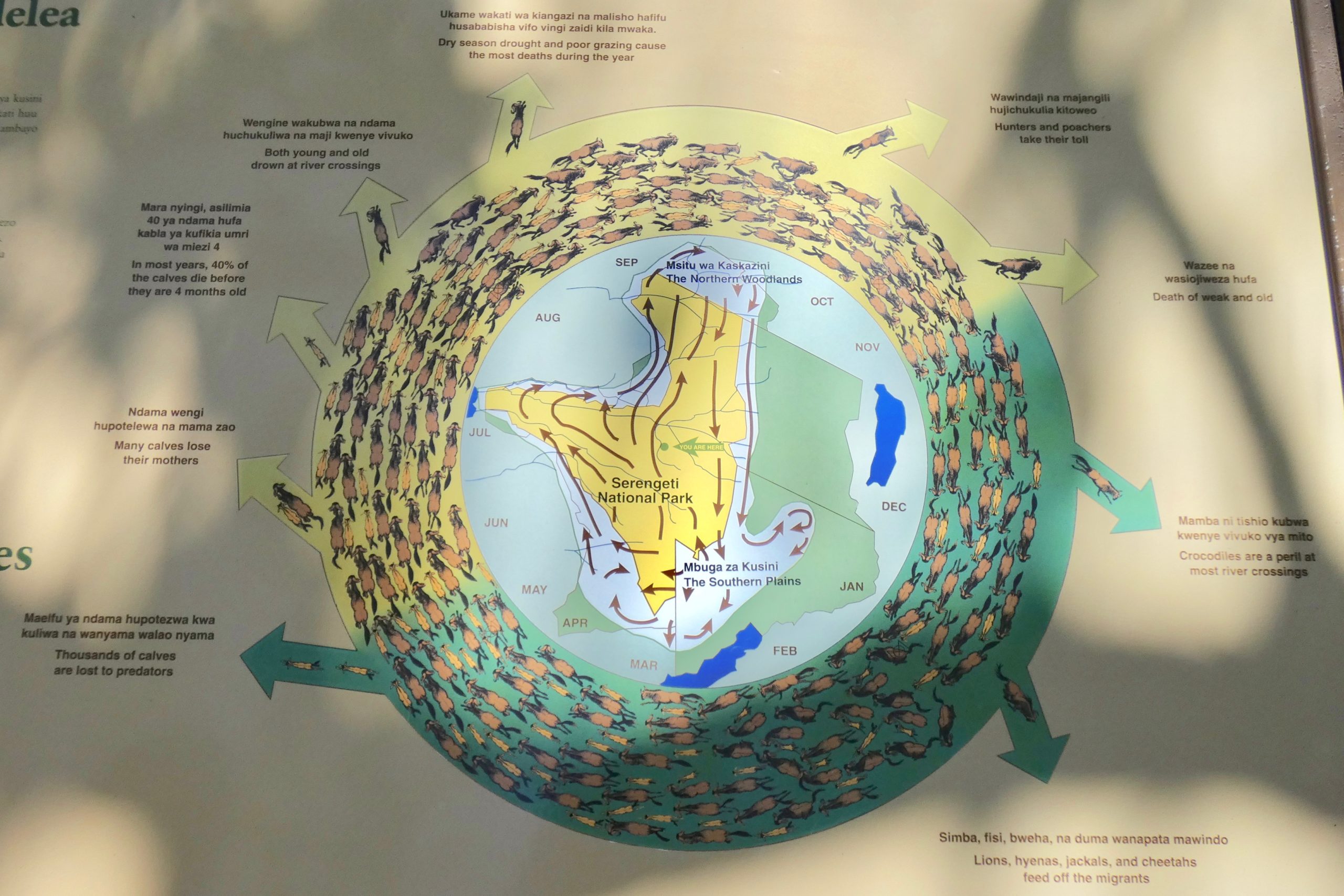
From January to March, the wildebeest can be found in the eastern part of the Serengeti in Tanzania, where they birth and raise their calves. By April and May, they have moved into central Serengeti and the mating season begins.
In June and July, they start heading to north-western Serengeti, and between July to October they make the crossings across the Mara River into the Masai Mara of Kenya. By November and December, they cross back into the southern Serengeti.
Although the migration path doesn’t change much, the timing will vary slightly from year to year depending on Mother Nature, so timing our trip for the river crossings was a bit of a gamble. In the end, we chose the beginning of August and hoped for the best.
The Tour
There were so many places in and around the Serengeti that we wanted to hit on this trip. With seven nights, we had to prioritize what we wanted to see and do.
We don’t normally bother with tour companies, but a safari is probably one time you definitely want to find a good one. A knowledgeable guide can really enrich the experience and point out things that an untrained eye would never catch. They also know the culture, customs, safety considerations and their way around the parks like the back of their hand.
There are many safari tour operators in Tanzania. We ended up going with Gosheni Safaris, a local company that continues to rated highly on TripAdvisor. Not only were they at least 25% cheaper than other international tour operators, but we also wanted to support the local community.
In all our interactions with Gosheni Safaris, they were very professional and prompt in responding to emails. I gave them the destinations and the accommodations we wanted and the budget we had to work with. They gave their suggestions and then put together a personal itinerary for us.
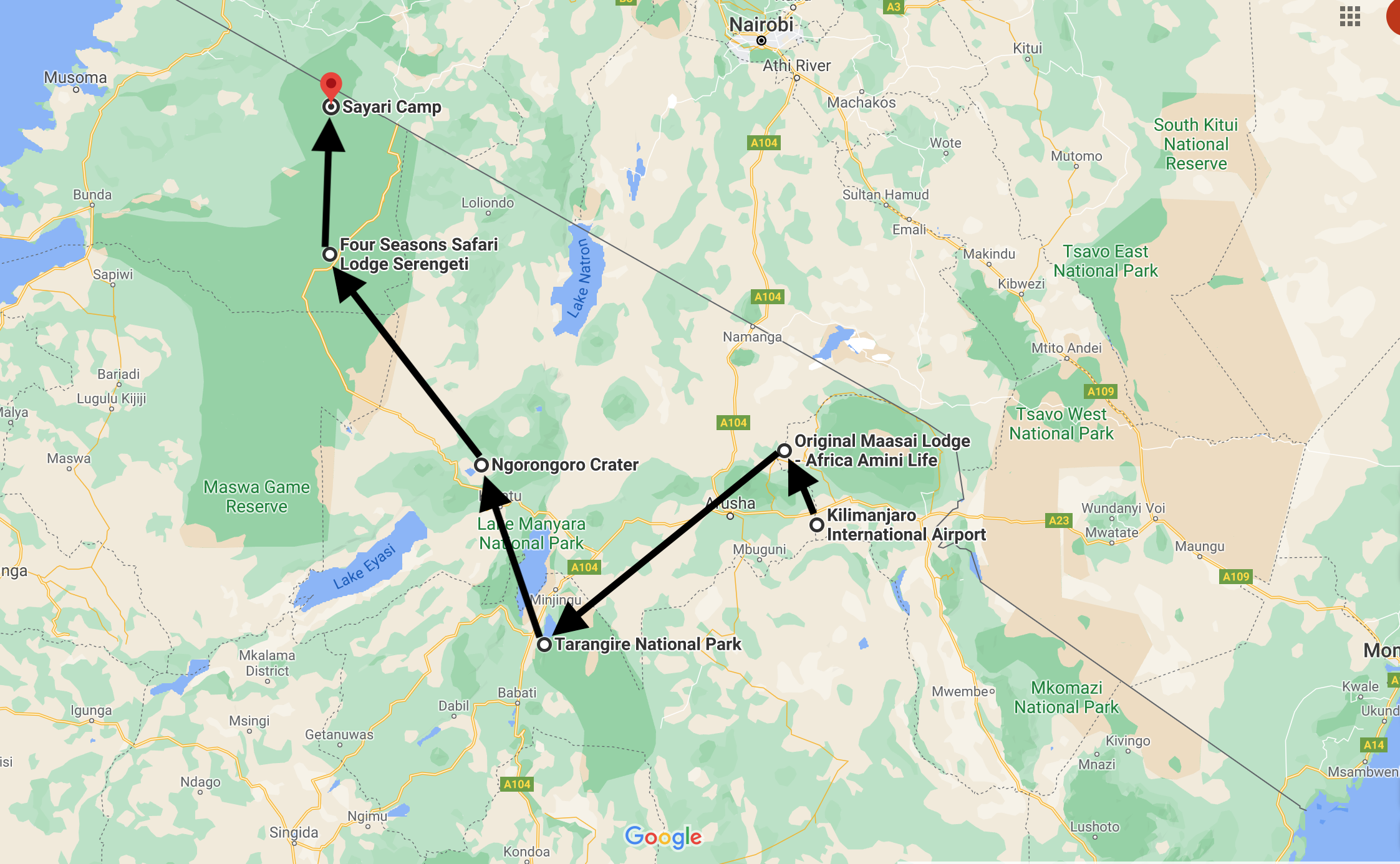
Day 1: Arrival in Tanzania
Accommodation: Amini Life Masaai Lodge
After our layover in Cairo, Egypt, we were off to Dar Es Salaam, our entry point into Tanzania. Visas can be acquired on arrival, but we didn’t find the process very efficient or the custom officers very helpful. Even though we were one of the first to submit our passports, we were one of the last to get our visas, and the whole process took about an hour.
We then caught a domestic flight into Arusha, where most safaris start from, on FastJet, a local carrier. I was a little anxious about this flight, as the reviews on the airline were mixed with reports of random flight cancellations and delays, but thankfully we didn’t encounter any issues.
As we were landing in Kilimanjaro Airport (JRO), we were lucky enough to catch a clear view of Mount Kilimanjaro, which was a rare sight as its peak is often obscured by clouds.
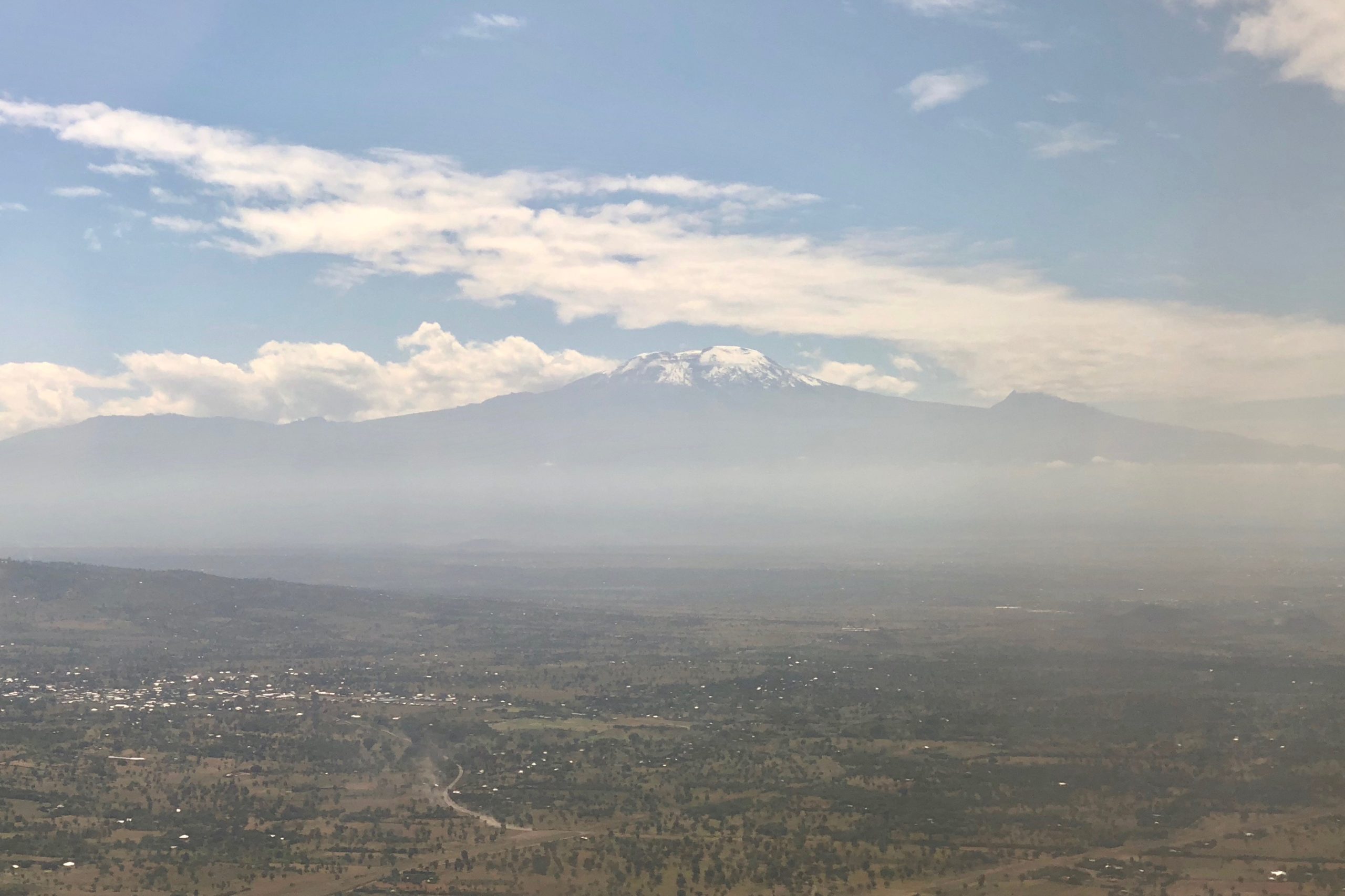
We were greeted by a porter who took us out to our safari vehicle, where we were warmly greeted by a gentleman whom I mistakenly thought was our guide, but soon found out was Peter Gosheni, the owner of Gosheni Safaris!
He gave us each a wide-brimmed safari hat before driving us an hour and a half to our first accommodation: Amini Life Masaai Lodge.
It was amazing watching him navigate us there, because I’m pretty sure at some point, we weren’t even on a road, and there were a couple of times I wondered if we were lost. But in the end, we got there.
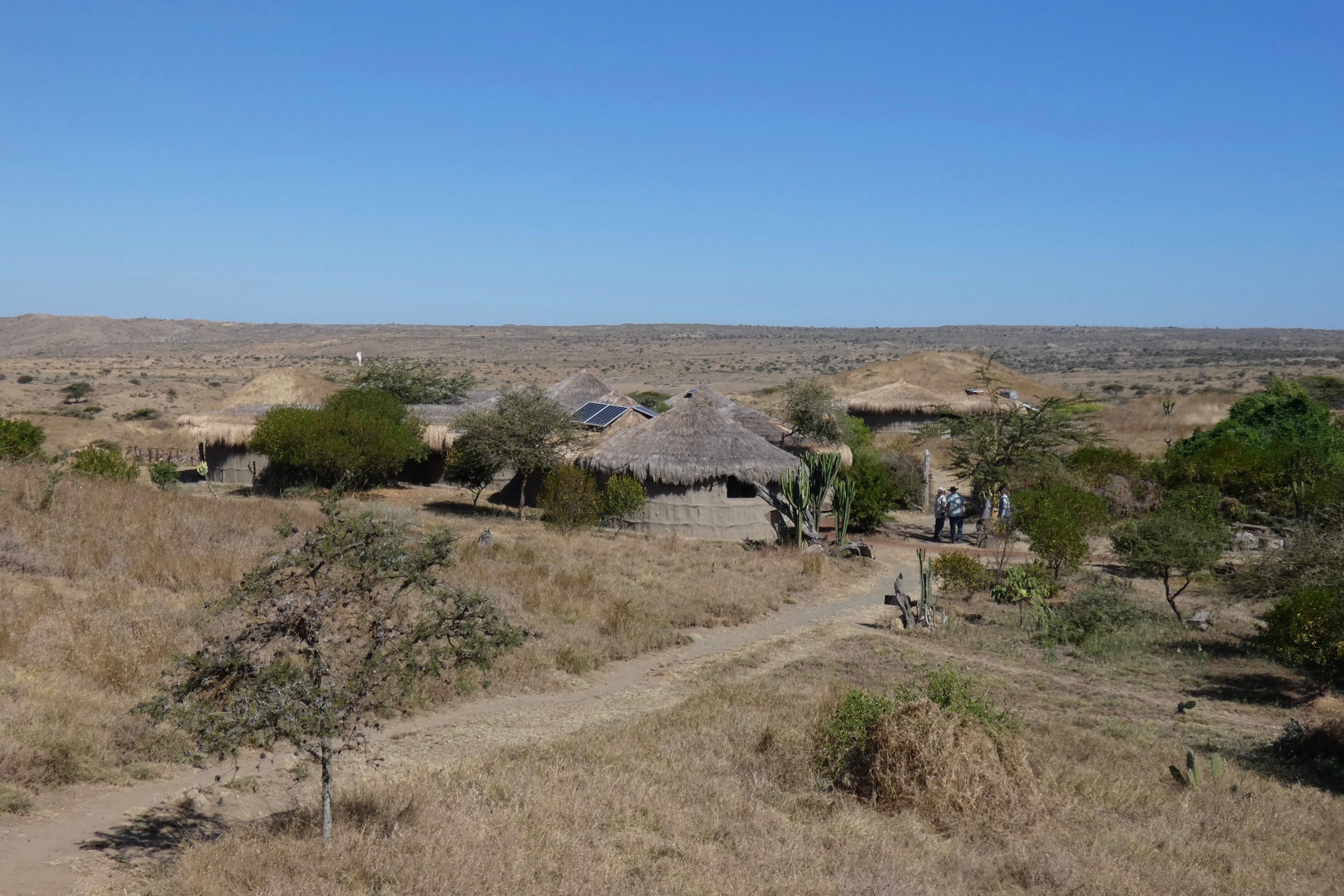
The Amini Life Masaai Lodge isn’t a typical accommodation option offered by tour companies, as it’s a little off the beaten path. We requested it specifically because it is run by a non-profit organization and all the proceeds of our stay would go to the local Masaai tribes and humanitarian projects in the area.
The lodge is run by the Masaai and the accommodation is set up to resemble that of a Masaai village. Guests stay in their own earth hut made of cow dung, mud, and sticks.
Although simple on the outside, they were quite cosy on the inside with traditional decor, but packed with most amenities you would find in a hotel: warm running water, a flushing toilet, and solar-powered outlets.
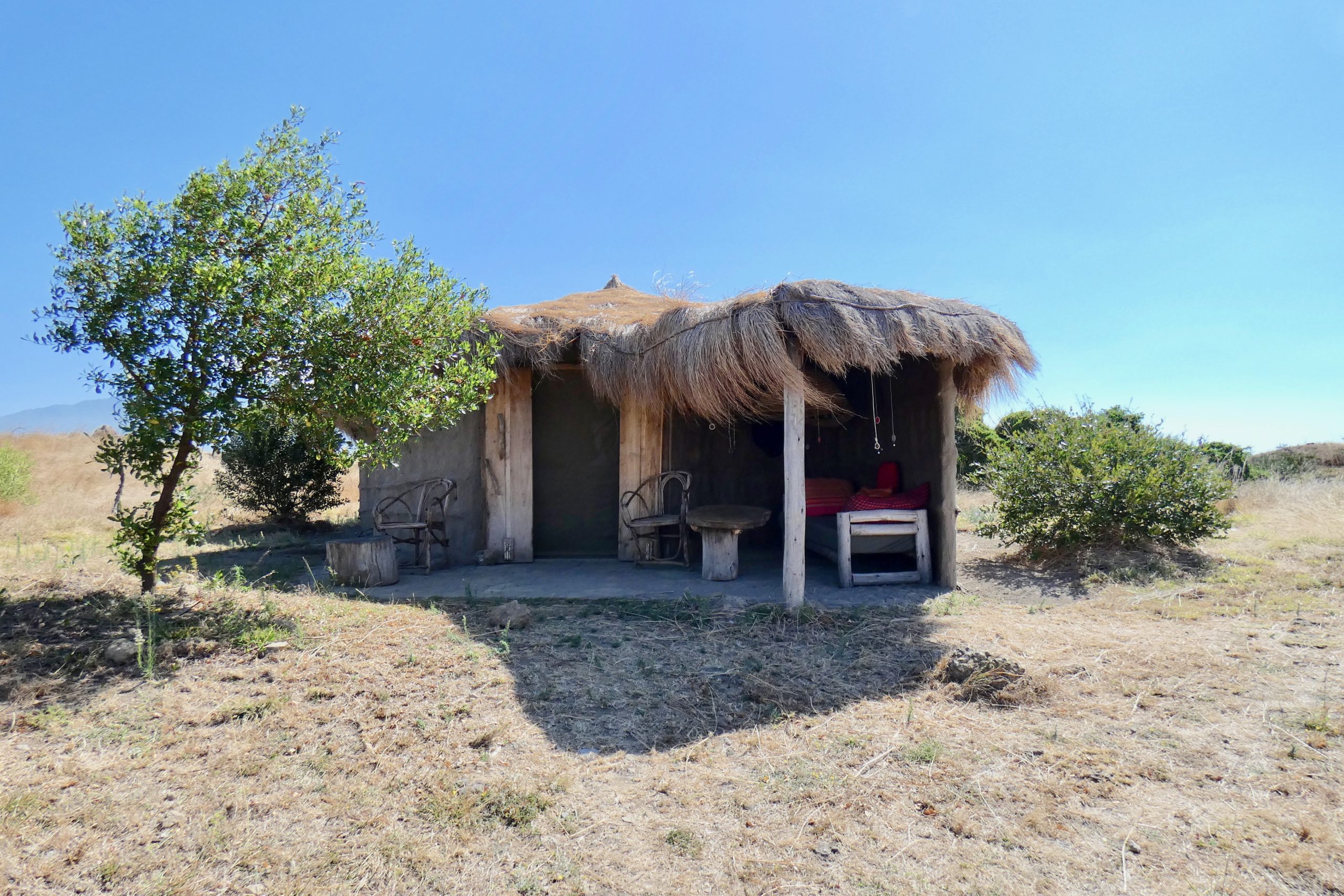
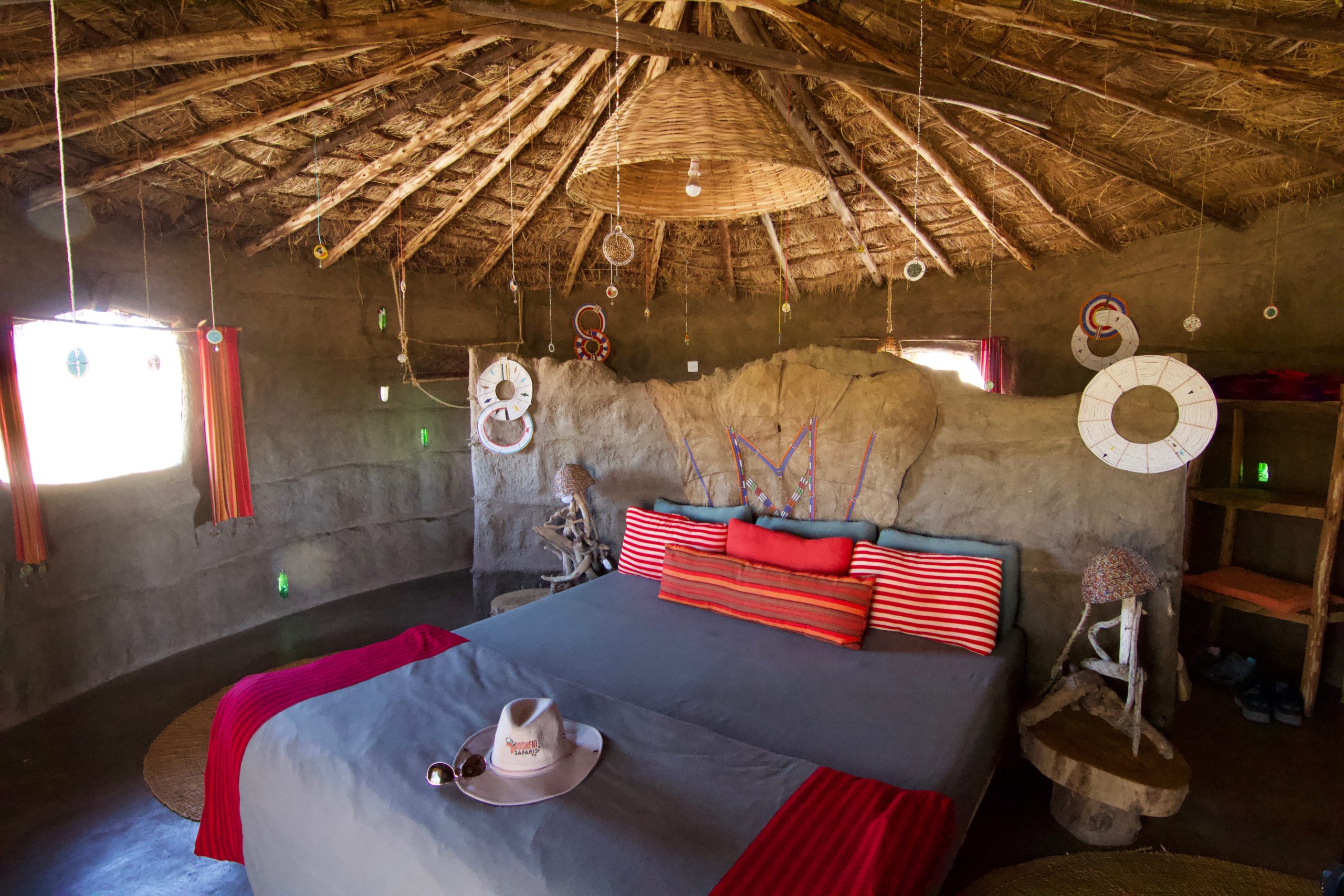
When we arrived, we were greeted by a few Masaai warriors who offered us a welcome drink – a cup of cow’s blood – considered a staple in their diet and believed to give them energy and strength. I kindly declined, but of course they smiled and revealed it was only berry juice for guests.
After lunch, a Masaai guide took us on a nature walk, where he pointed out local plants and wildlife all the while explaining their traditional way of life. They are farmers by trade and rely heavily on the rains for the survival of their crops and cattle.
While our parents may remind us of the times they had to walk 2 km to get to school once upon a time, travelling by foot is still the main means of transportation here. As a matter of fact, our guide would walk almost a day to get back to his tribe when done his weekly shift at the lodge.
After the walk, we joined others at the lodge for a session on spear throwing and traditional Masaai dancing. Dinner was delicious and consisted of traditional and western fare. They even roasted beef and lamb over a fire pit.
Afterwards, there was more time to mingle with the Masaai, but we were pretty wiped and called it a night.
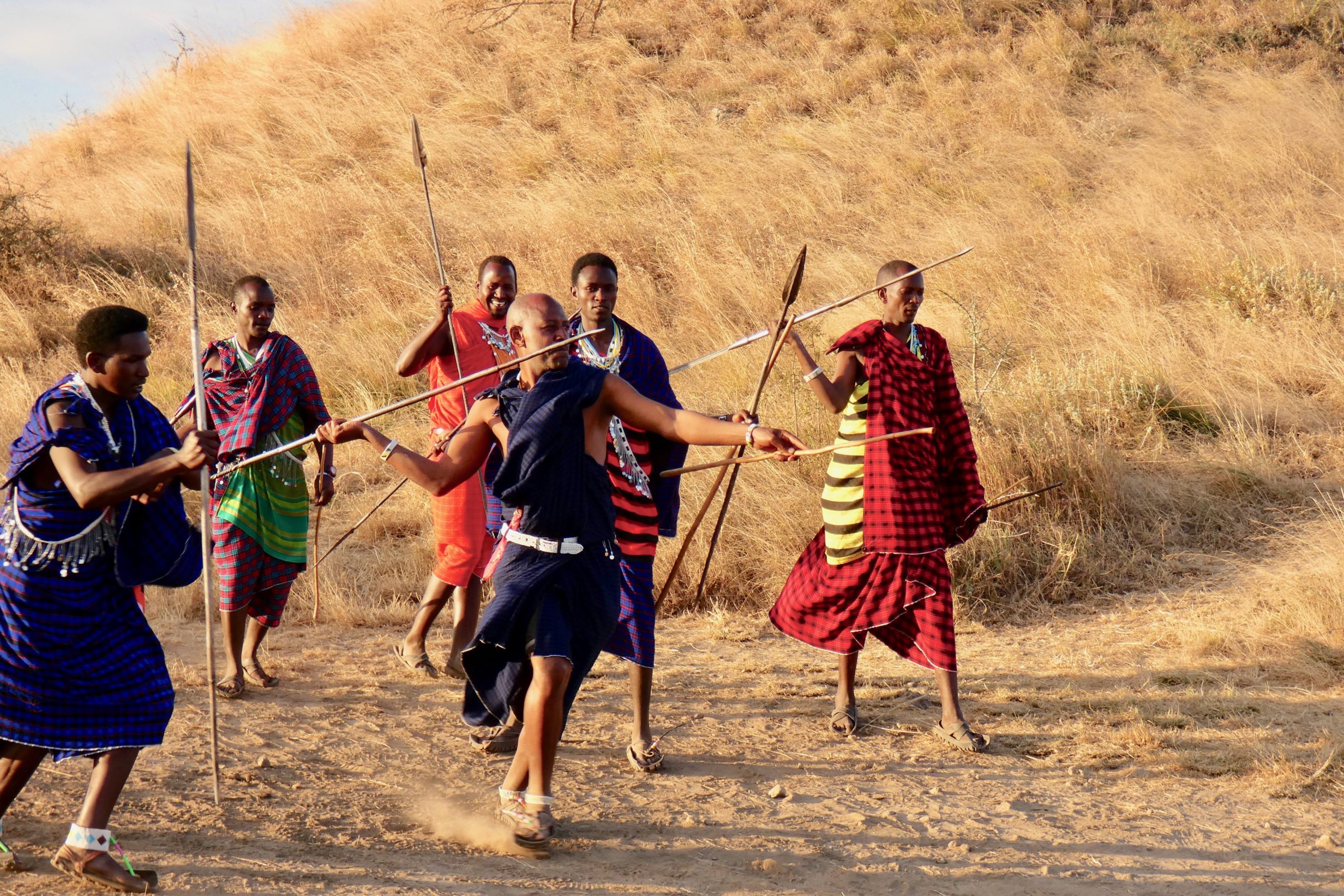
My only regret here was that we didn’t stay an extra night. What better way to begin our travels in East Africa than by getting to interact with the locals and experience a bit of their culture and traditions.

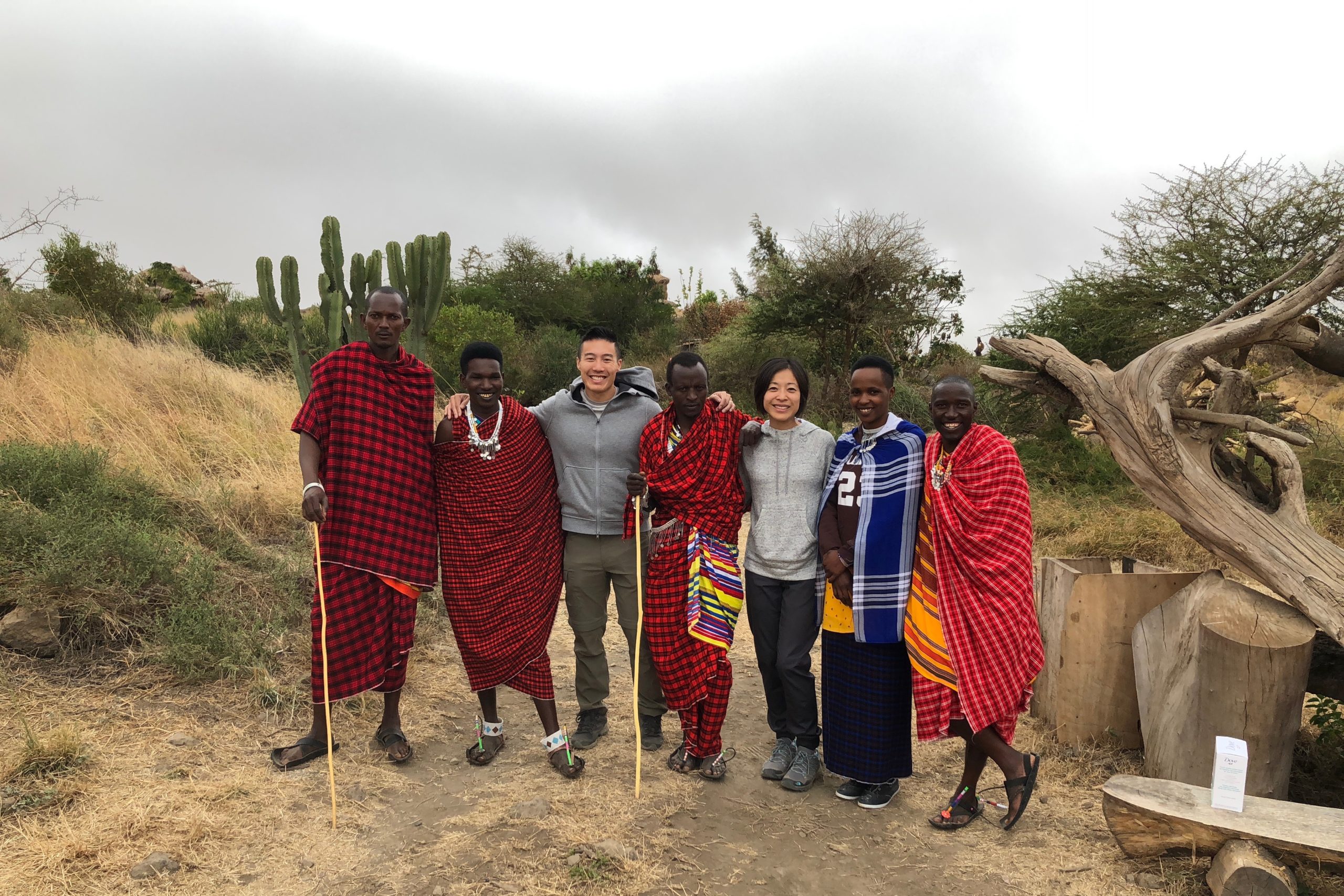
Day 2: Tarangire National Park
Accommodation: Kitela Lodge
We were greeted in the morning by our Gosheni guide, Gabriel, who would be accompanying us for the rest of our safari.
We hopped into our 4×4 safari vehicle with a pop up roof and headed to Tarangire National Park, known for its elephant herds. It would be a two-hour drive to get there, but it was by no means a boring drive.
We drove through villages and caught a glimpse of life in Tanzania. We saw young boys herding cattle and women skilled enough to balance huge jugs of water on their heads.
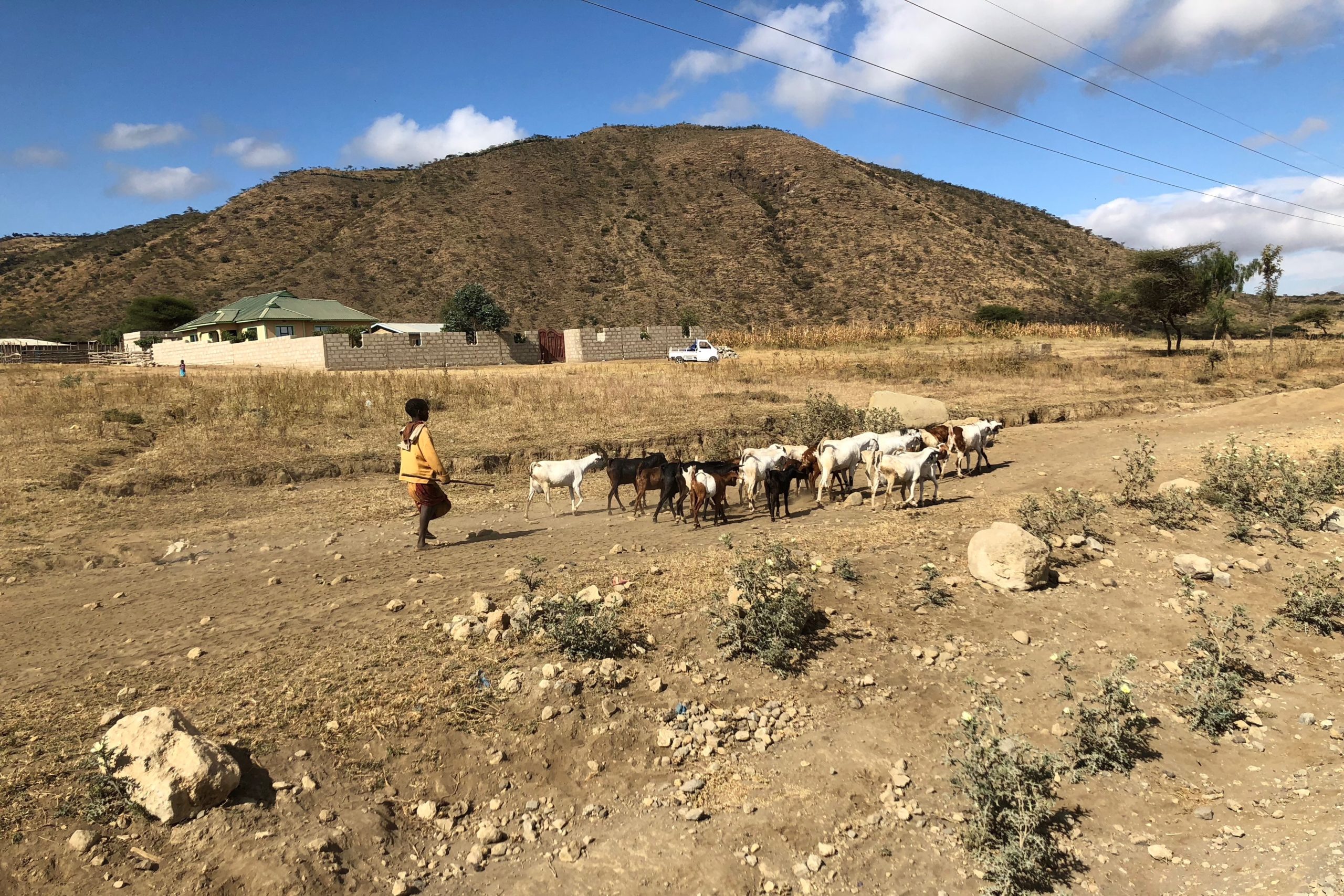
Along the way, we were stopped on the road by local police. Gabriel didn’t seem alarmed. He showed the cops some papers and we were soon on our way. Apparently this is not an uncommon occurrence in Tanzania, where law enforcers will often try to fault locals for anything to get a bribe.
Arriving at our first park, I wasn’t sure what to expect, but we were soon greeted with the sights and sounds of zebra, baboons, wildebeest, warthogs, ostriches, vultures, impalas and large herds of elephants.
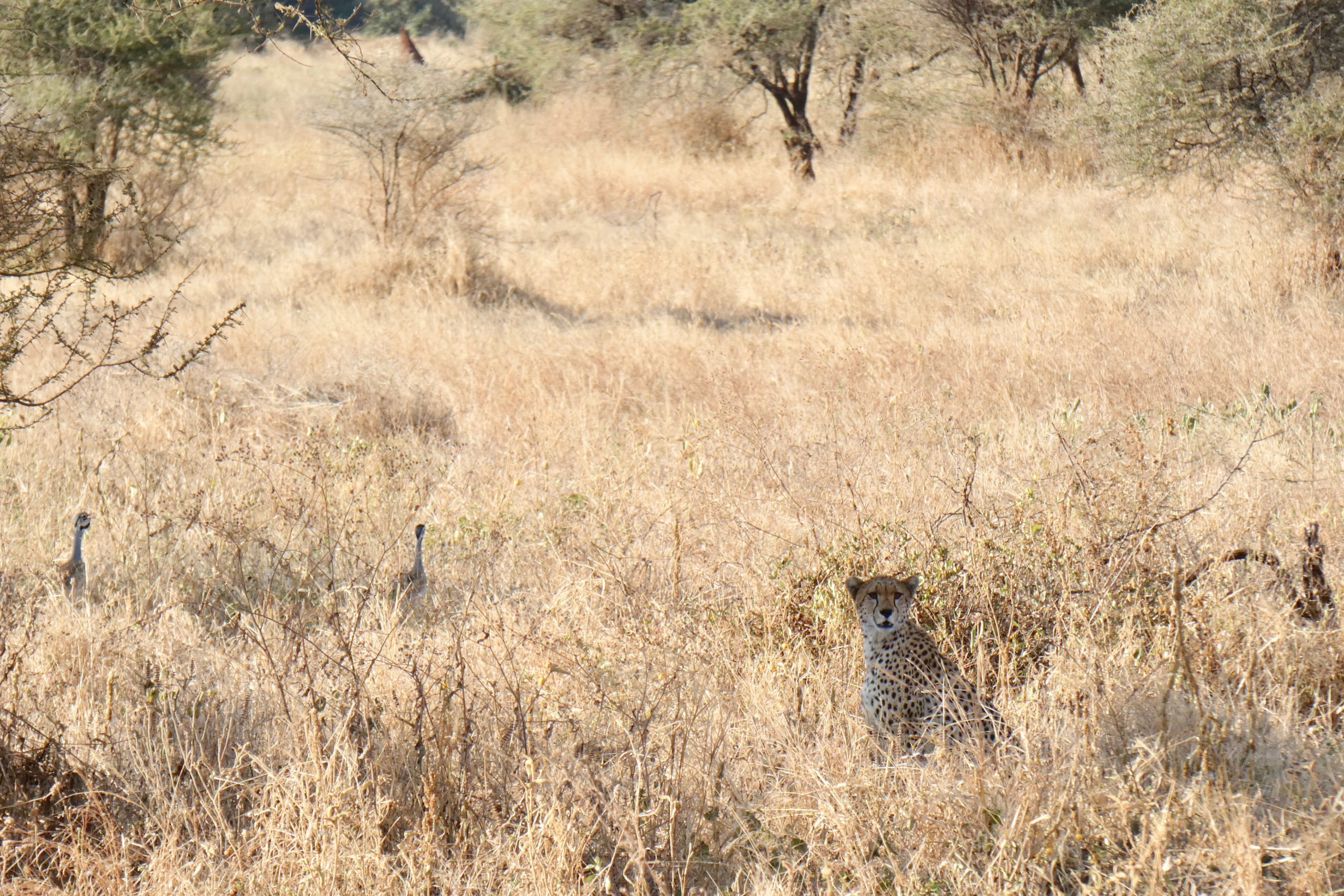

It was breathtaking to see the beauty of these creatures in their natural setting. At one point, we had a small herd of elephants cross right in front of our vehicle. They were literally within several feet of us. We were asked to stay still and quiet so as to not startle them, as that would likely mean we would need a new vehicle. 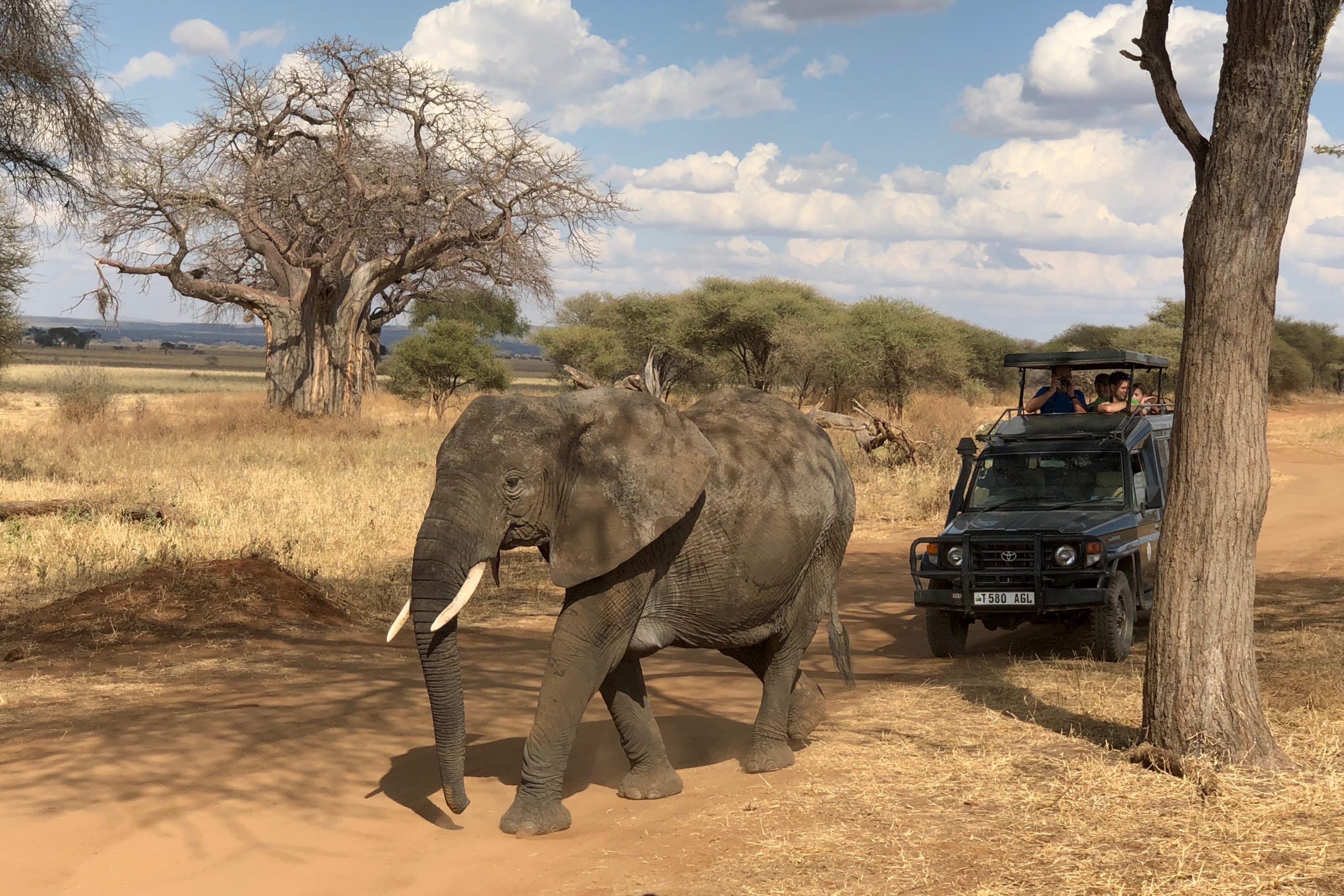
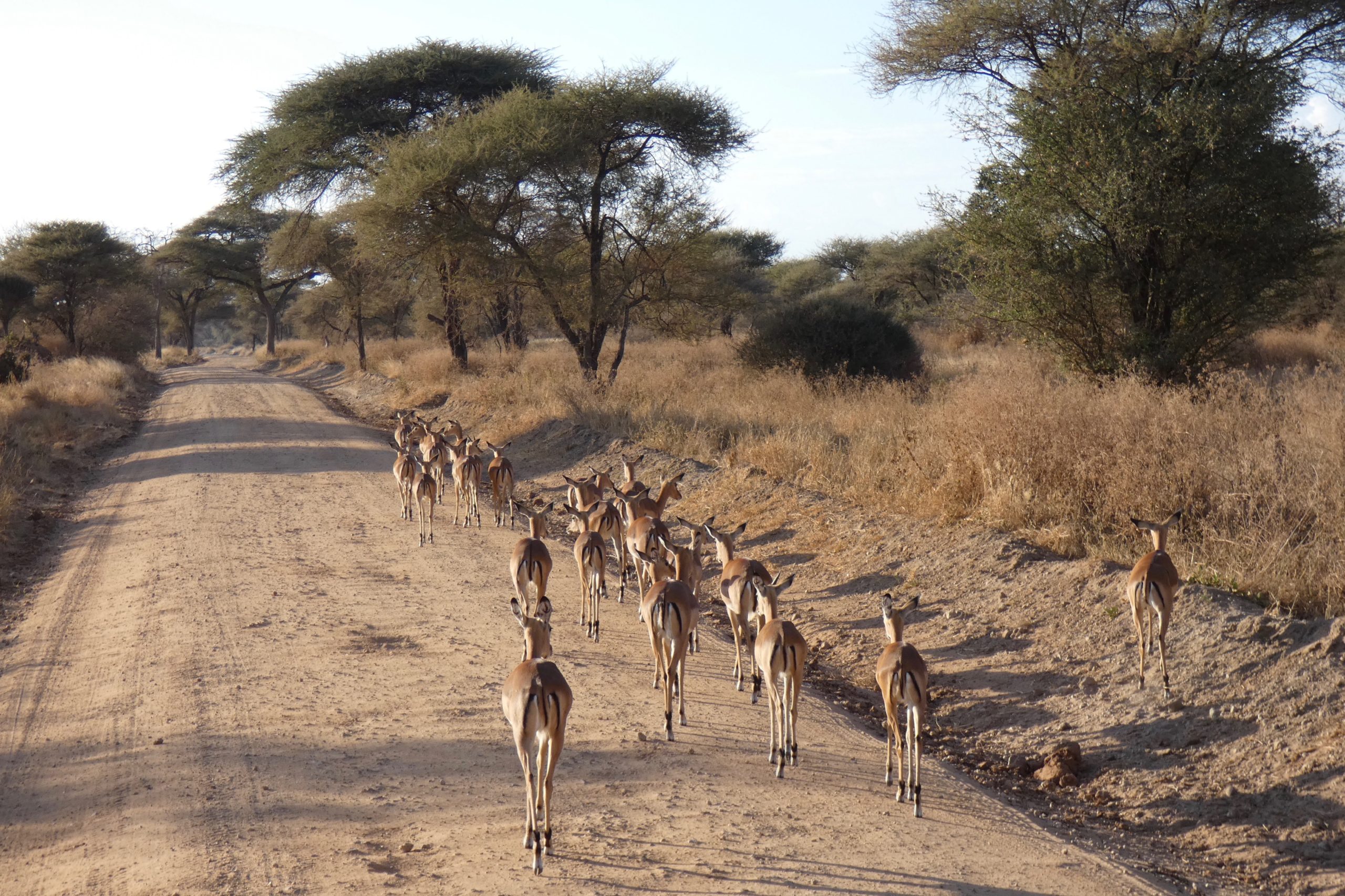
It was now late afternoon and it would take us another two hours before we got to our accommodation for the night, Kitela Lodge, a more rustic hotel overlooking a coffee plantation that is in close proximity to Ngorongoro Crater, our destination for the next day.
Day 3: Ngorongoro Crater
Accommodation: Ngorongoro Crater Lodge
We woke up this morning and explored the hotel grounds which showcased a variety of lovely flowering plants, including coffee plants.
I had never seen a coffee plant before and it totally was not what I had envisioned it to be. They had green leaves and red berries, and within these berries were a couple of seeds which are the traditional coffee “beans” we are used to. They didn’t taste so good raw though.
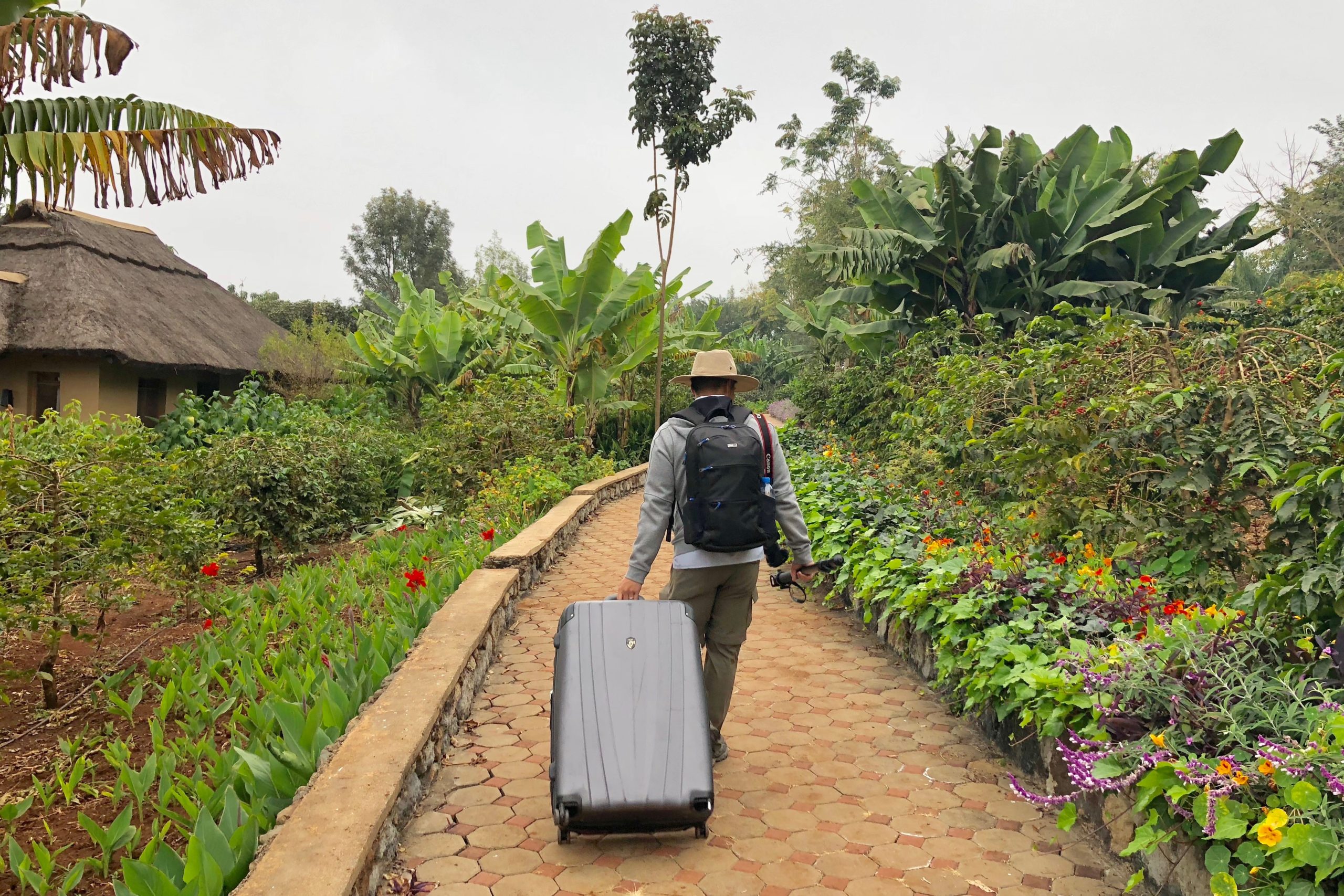
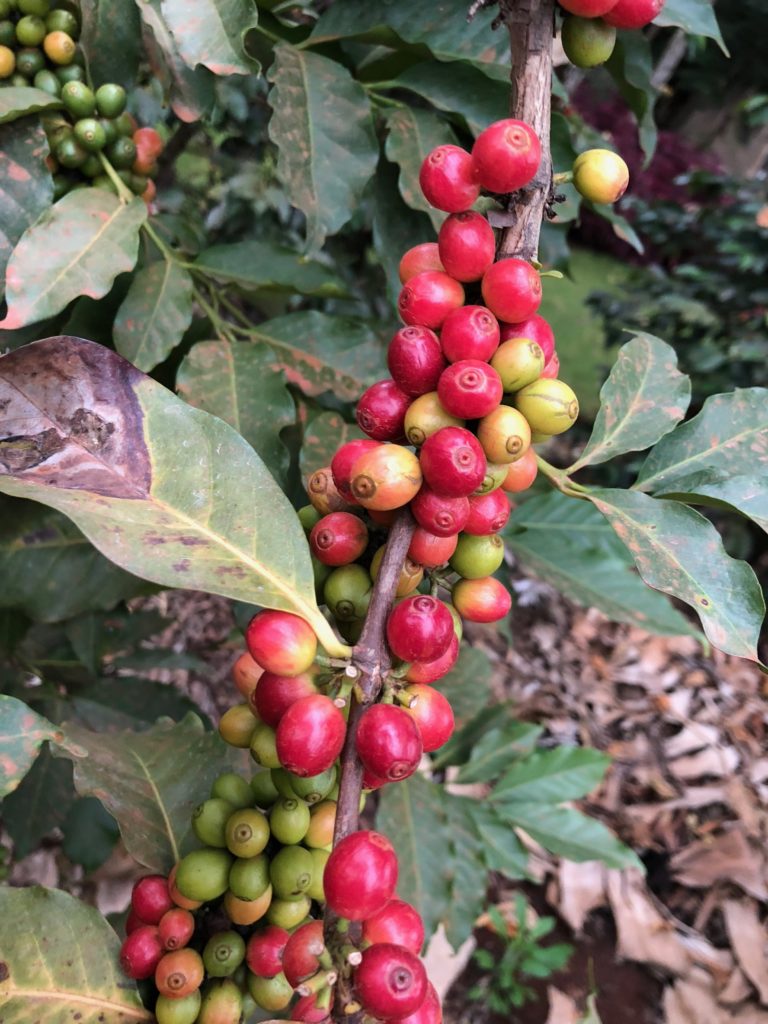 After breakfast, we were on our way to the crater. We made one quick stop at a local artisan market just off the side of the road and were able to pick up some souvenirs for the kids. Unlike some places were souvenirs are just mass produced, locals were actually hand making some of these on site, including a young man painting images of the Masaai.
After breakfast, we were on our way to the crater. We made one quick stop at a local artisan market just off the side of the road and were able to pick up some souvenirs for the kids. Unlike some places were souvenirs are just mass produced, locals were actually hand making some of these on site, including a young man painting images of the Masaai.
The Ngorongoro Conservation Area is a UNESCO World Heritage Site. It is a large crater that formed when a volcano collapsed some three million years ago. At a depth of 610 meters, the base of the crater covers 260 square kilometres and is the home to over 25,000 large animals, including critically endangered black rhinoceroses, the densest known population of lions, and over 500 species of birds including the ostrich, white pelican, and flamingos.
We zigzagged our way up the outside of the crater, then back down into the crater. It was pretty quiet from a wildlife perspective at this point, but that quickly changed once we reached the crater floor. There were water buffalo, zebras, and wildebeest in every direction.
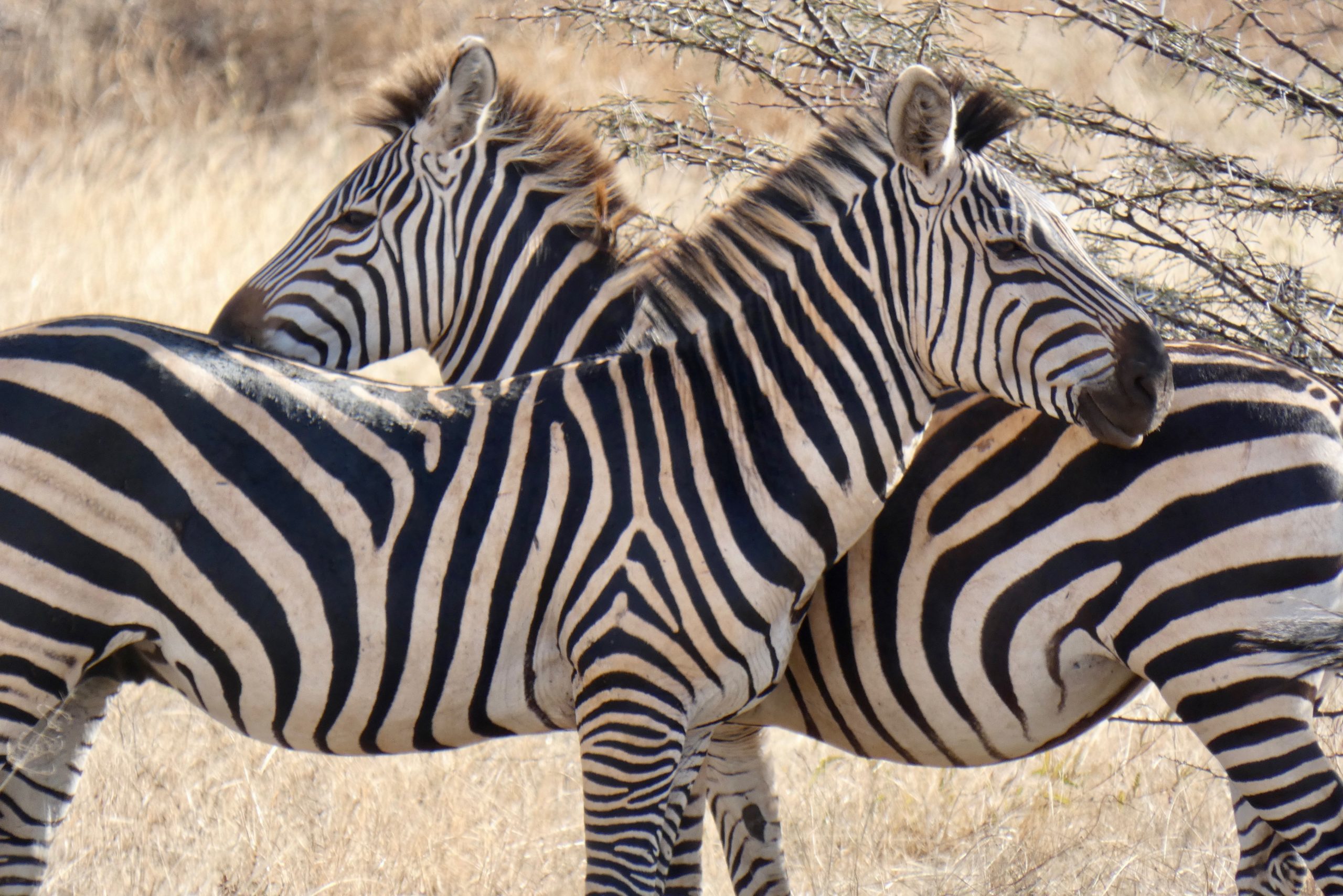
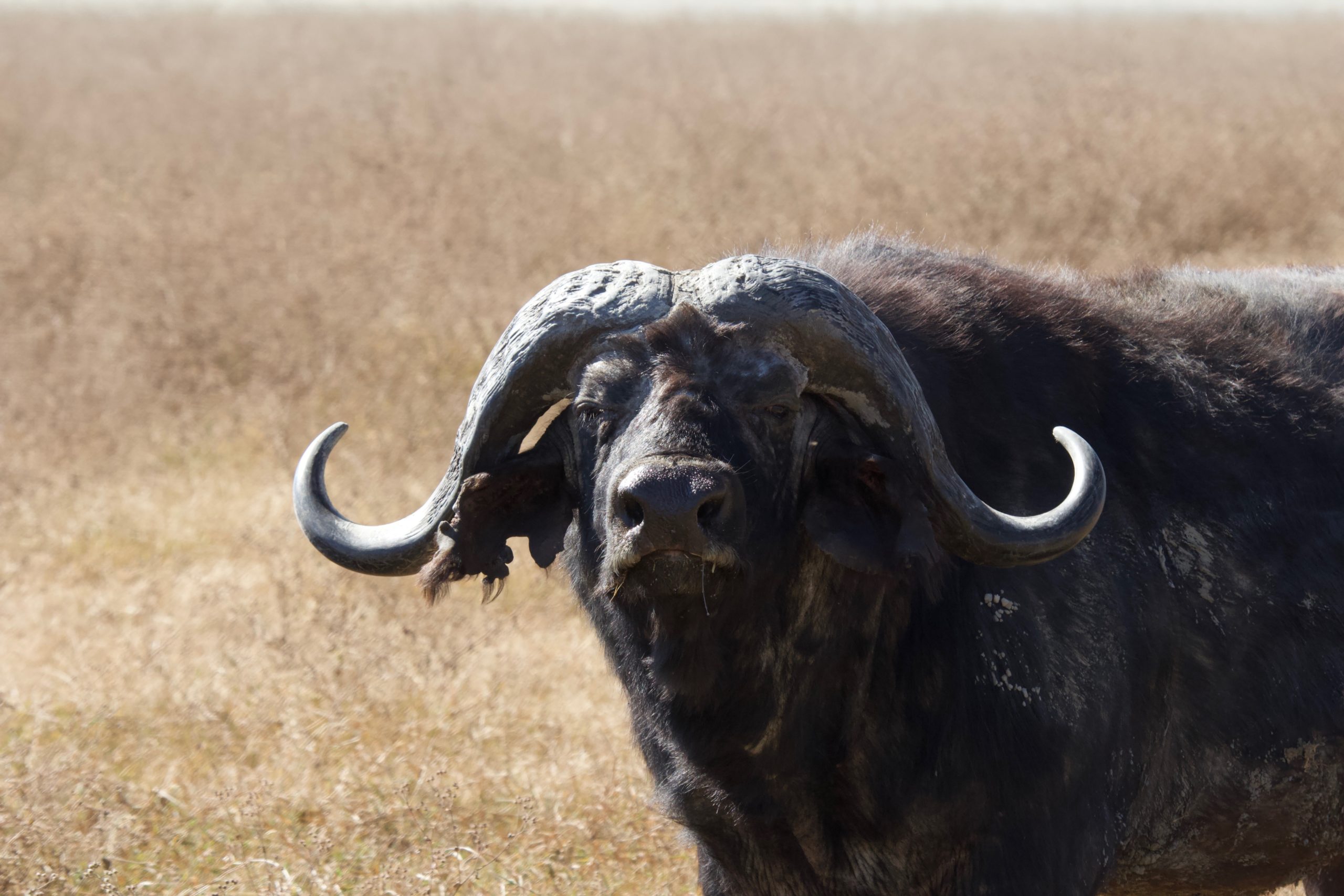
Driving around, we also saw jackals, hyenas, hippos wallowing in ponds, and a few ostriches roaming around.
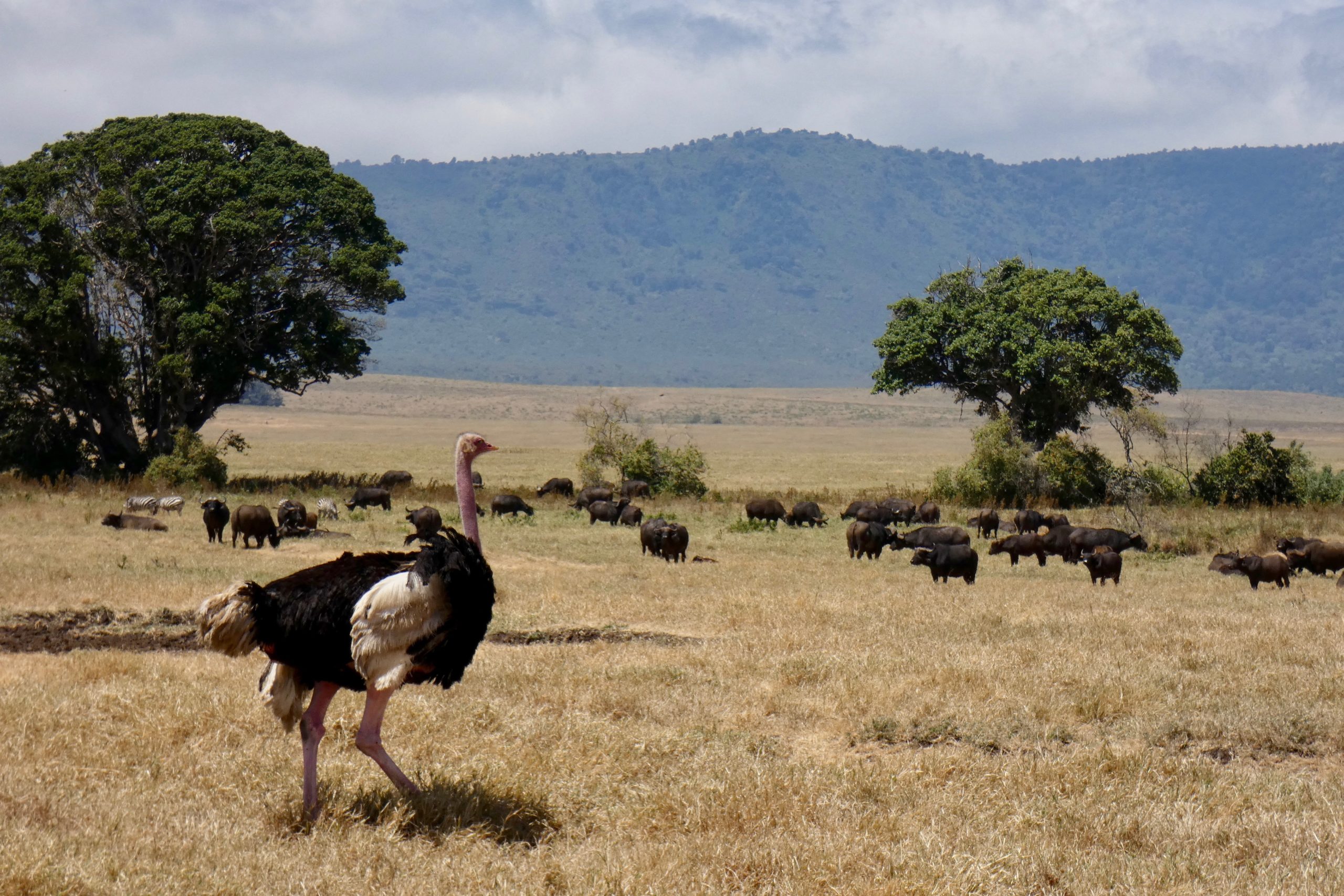
We came across a pride of lions which to the untrained eye could have been easily missed, as they were lying down in the grass which camouflaged them.
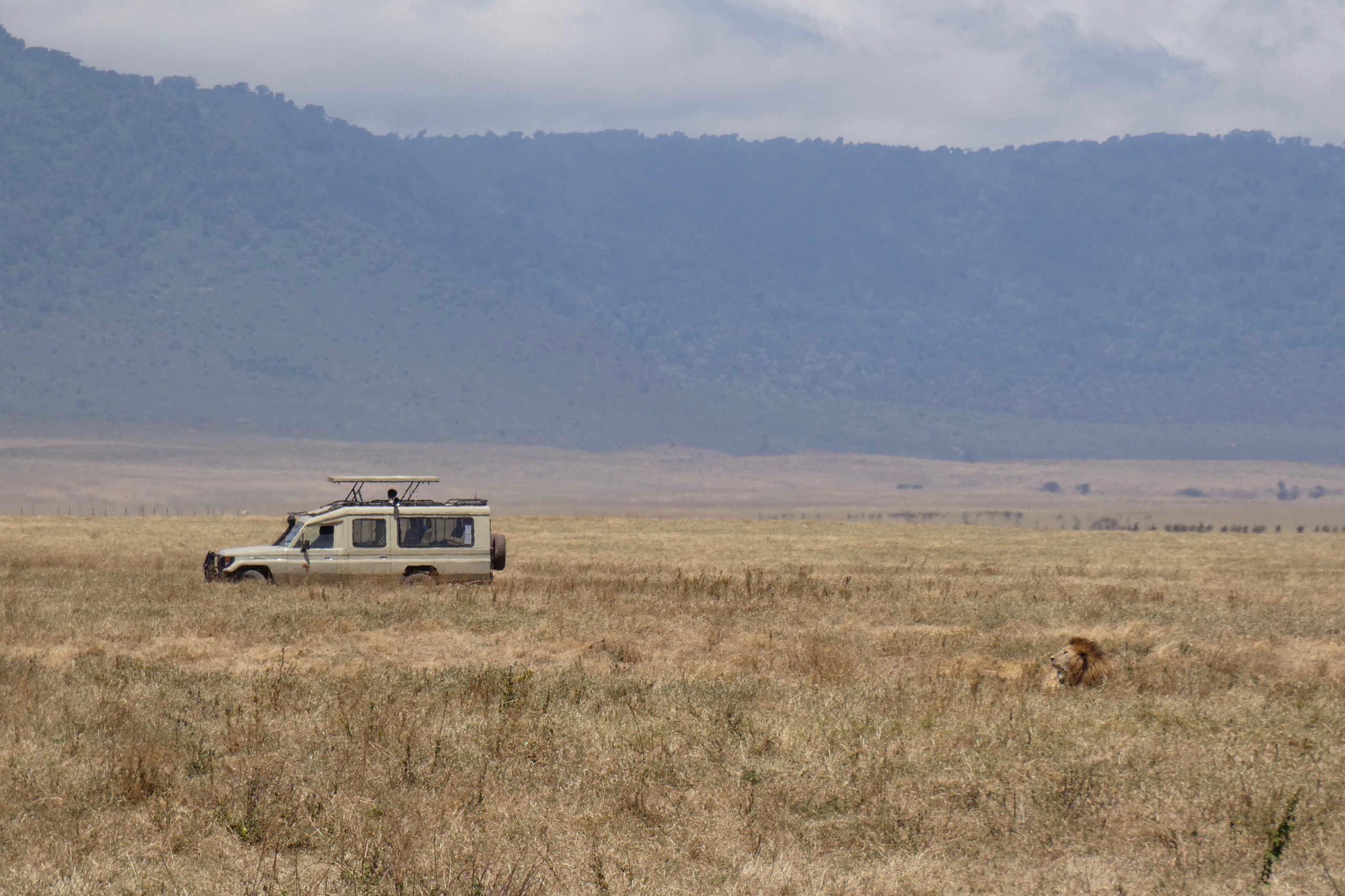
We took a late lunch in a designated area in the crater where we could get out of the vehicles and walk around. Gabriel set up a little table for us and we had our boxed lunches from our hotel.
As we were packing up, we heard a lot of activity over the paging system. We asked Gabriel what was going on and he said a pair of black rhinoceroses were spotted. As we made our way to the location, we saw almost every vehicle in the park heading in the same direction. Normally you wouldn’t see more than a few vehicles at a time, but the one exception is when a guide spots something exciting and pages everyone else in the area.
You would think that a black rhinoceros would be easy to spot in the backdrop of the yellow grasslands, but with only 26 of them in the crater, they are actually quite elusive. When we arrived at the site, vehicles were lined up all around the area.
The rhinoceroses were quite far in the distance, but nothing my new Panasonic Lumix with 60x optical zoom couldn’t handle. It was a mother and her calf grazing and lying around. What a sight to end off the day’s drive!
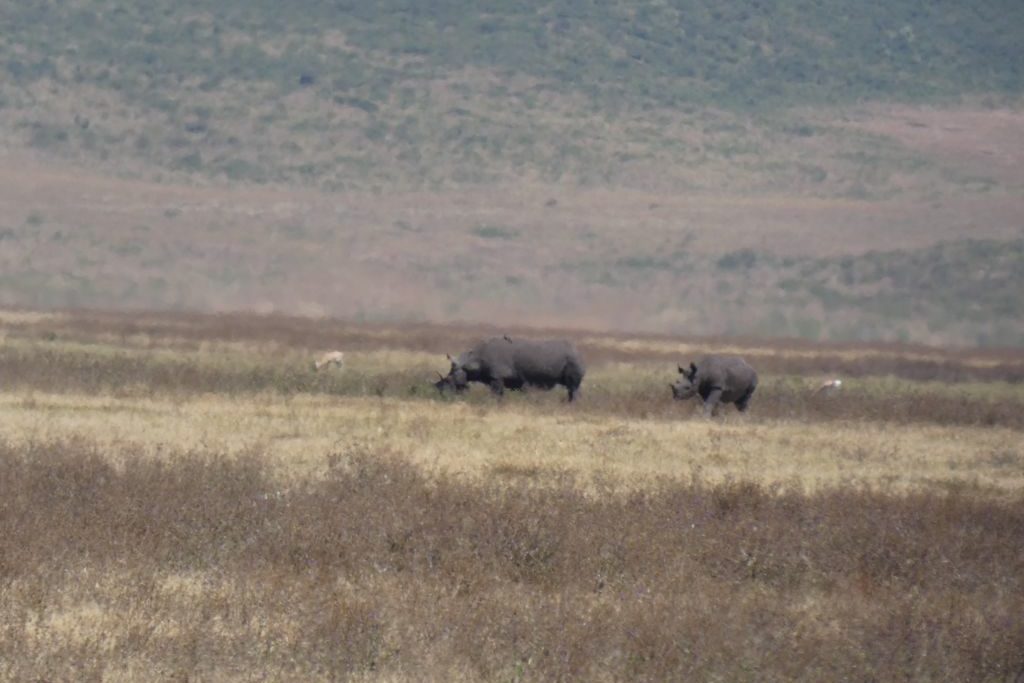
We then headed to our accommodation for the night, Ngorongoro Crater Lodge. We really splurged here, and if we were to come back, I would probably stay elsewhere, but I had read that the unobstructed view of the crater from here was surreal, and sure enough, we were not disappointed by it. We arrived to our hosts welcoming us with song and dance. The service was impeccable, and the dining Michelin worthy.
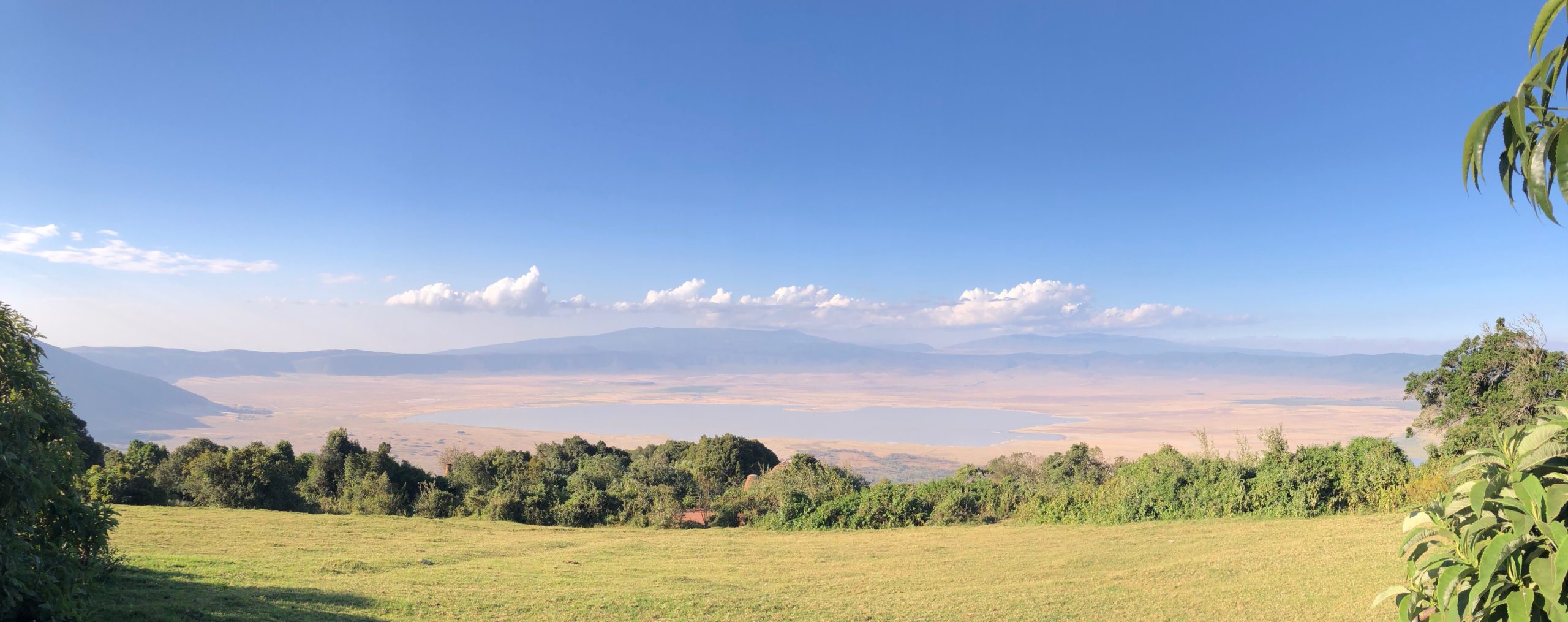
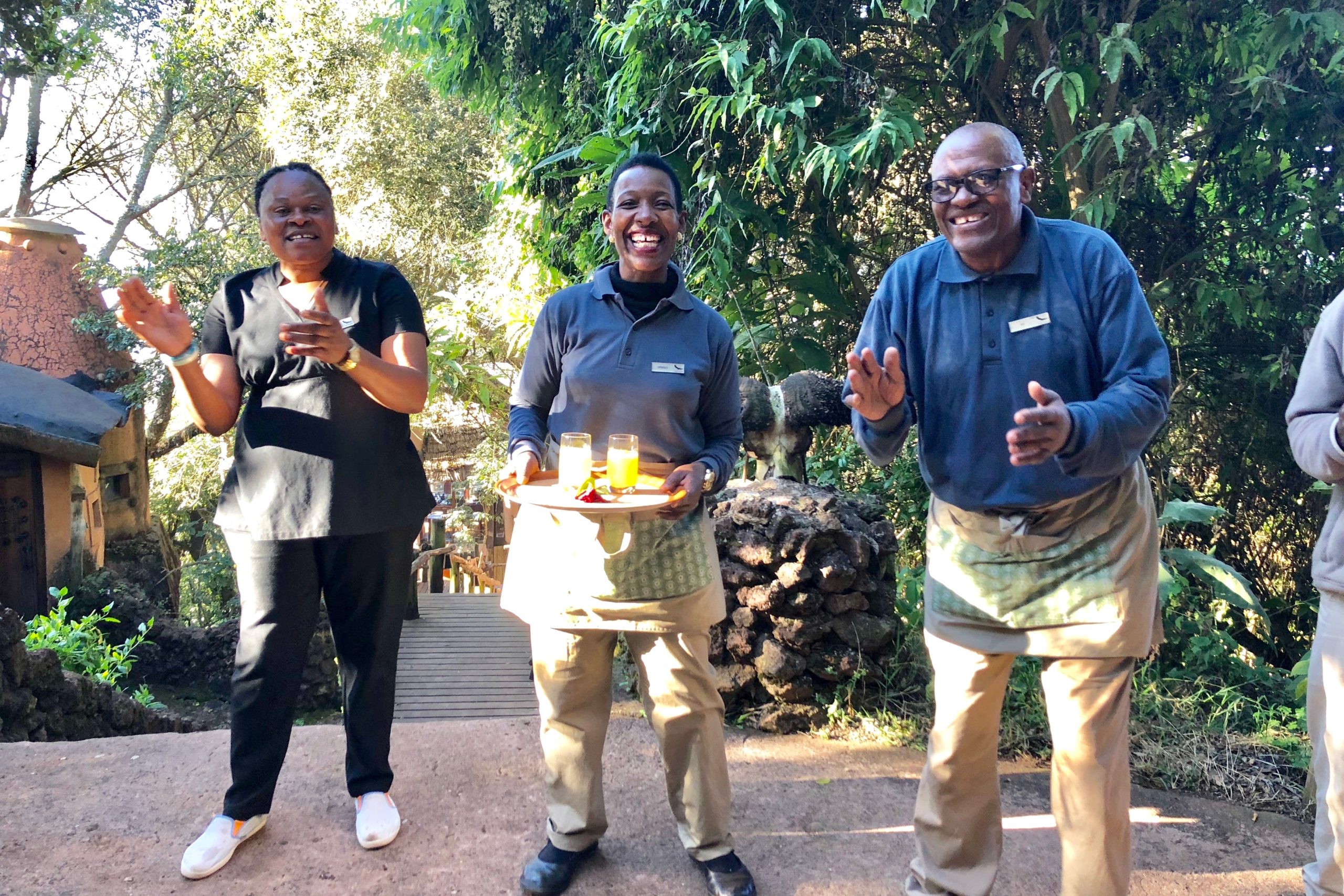
After dinner, it was pitch black and a staff member with a flashlight escorted us back to our cabin. It wasn’t until next morning that I fully appreciated this service…
Day 4–5: Central Serengeti
Accommodation: Four Seasons Safari Lodge Serengeti
As we left our cabin this morning for breakfast, we noticed a couple of staff looking through the underbrush of the forest just off the path to the main lodge. Apparently a jaguar had killed a dik-dik antelope just below our cabin an hour earlier.
Needless to say, that sent a bit of a chill up my spine and served as a reminder that even in this beautiful hotel complex, we were still living in nature’s backyard.
Today, we were heading to Serengeti National Park, and would be staying in central Serengeti for a couple of nights before heading further north. Some people opt to skip central Serengeti altogether and just head north to spend more time where the Great Migration is. However, we really wanted to check out the Four Seasons Safari Lodge and have a couple of laidback days to break up the long game drives.
Wifi access in our vehicle was definitely a great amenity to have on this day, as we had a four-hour drive ahead of us. I had plenty of stuff to keep me busy though, including going through the countless photos I had taken and catching up on some leisure reading. It also gave us a chance to talk to Gabriel about Tanzania as a country, and the ongoing issues they have with poverty, corruption, and poaching. He even taught us some Swahili!
Along the way, we passed some well-fortified Masaai villages (to keep the wildlife out) and groups of Masaai boys along the side of the road dressed in black cloaks with their faces painted white. These boys were going through a rite of passage into manhood. They would have been recently circumcised and then sent into the wilderness for several months. Once the ritual is complete, they would be considered Maasai warriors.

After 1.5 hours we arrived at the Serengeti’s Western gate, Naabi Hill Gate. As Gabriel dealt with our paperwork to enter the park, we hiked up to a hill there and saw the plains of the Serengeti lying before us. There were grasslands as far as the eye could see, with the odd tree sticking out in horizon. I totally underestimated the vastness of it.
Even when you’re not doing an official “game drive”, expect the unexpected. As we were en route into central Serengti, Gabriel pointed out various wildlife he spotted, including a lone tree in the distance with a leopard in it. Once again, I cannot believe how easily he was able to spot this. Not too long after, we received a few pages over the radio of other leopard and cheetah sightings, and so we took a few detours.
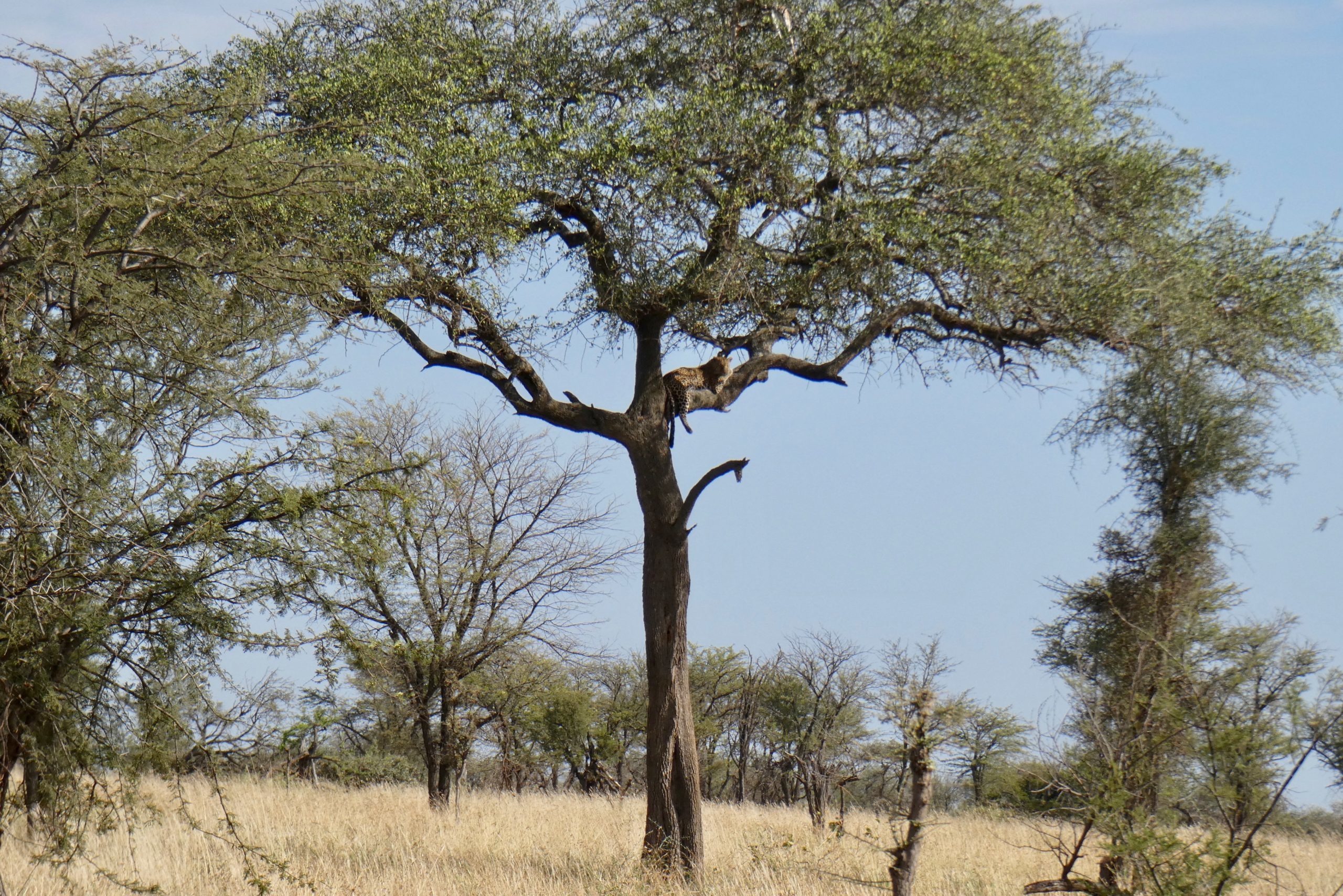
We got to the Four Seasons in the late afternoon. The property was amazing – a modern paradise within the Serengeti. Before dinner we took a dip in their infinity pool which overlooked a small waterhole and beyond that, the vast grasslands of the savannah.
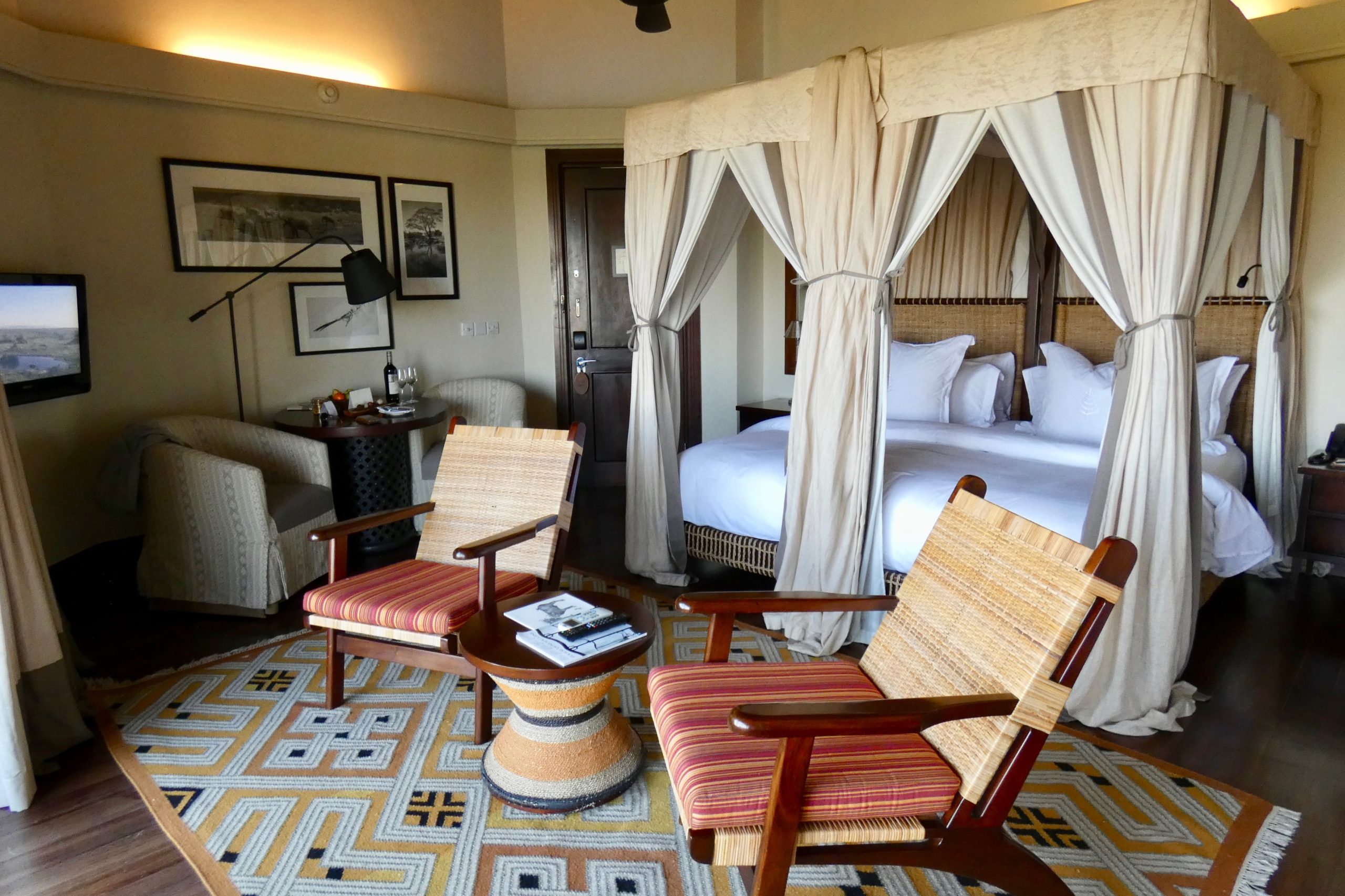

Although there’s a fence around the property, it’s not entirely cut off from wildlife and once in a while you’ll see a few baboons climbing on the rooftops, jumping from one building to the next.
We noticed blue and black fabric hung around the hotel and learned that they were to attract the tsetse flies. That’s when I understood why it’s not advised to wear jeans or black pants, as you’d be a fly magnet! I actually learned the hard way when I wore jeans to dinner at Ngorongoro and was bitten at least a handful of times.
The next day, we did a game drive in the morning in search of a black rhinoceros. Unfortunately, we didn’t find it. Back at the hotel, some guests had said they had seen a rhinoceros a day prior, but not any leopards despite spending several days now in the Serengeti. Meanwhile, we had now seen four. You really can’t predict what you will see when you’re there, so it’s best not to have expectations and then end up pleasantly surprised.
At the end of our game drive, we made a brief stop at the Seronera Visitor Information Centre, a small attraction with illustrations and information about the park, including detailed information about the wildebeest migration. There was also a life-size replica of a termite mound and various animal bones and skulls. Free tours were being offered by students with hopes of becoming safari guides in the future, as these are some of the most well-paid jobs in Tanzania.
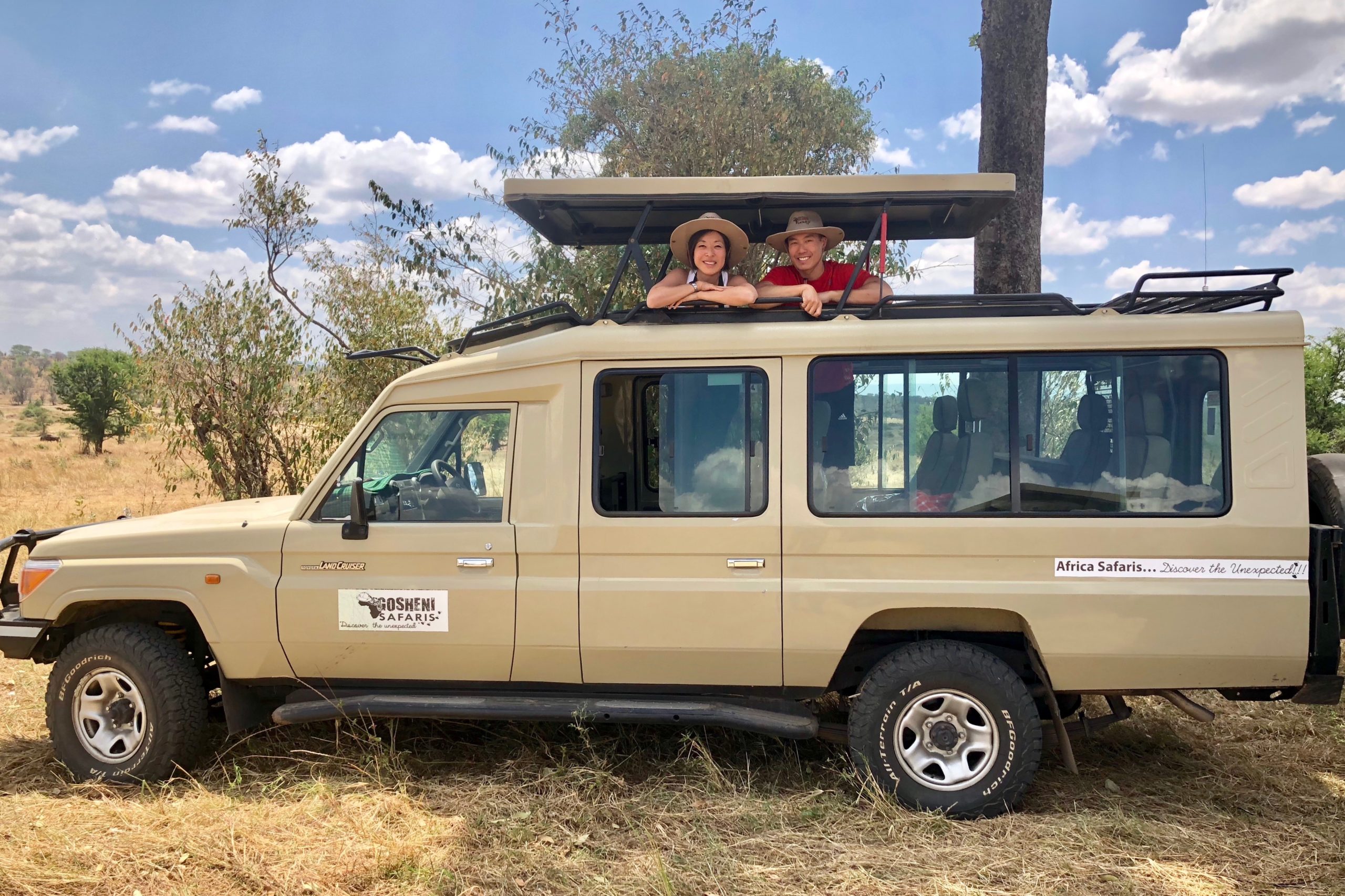
We got back to the hotel in time for a late sit-down lunch, then enjoyed some time by the poolside soaking in the sun and scenery before us. We did not regret our decision to enjoy the hotel. As awesome as the trip had been, it was hectic with early mornings and long drives, so some down time was nice.
Day 6–7: Northern Serengeti, Mara River region
Accommodation: Sayari Camp
Leaving the Four Seasons was bittersweet. We were heading to the Northern Serengeti today, to finally see The Great Migration. Little did we know that this was about to become our most action-packed day.
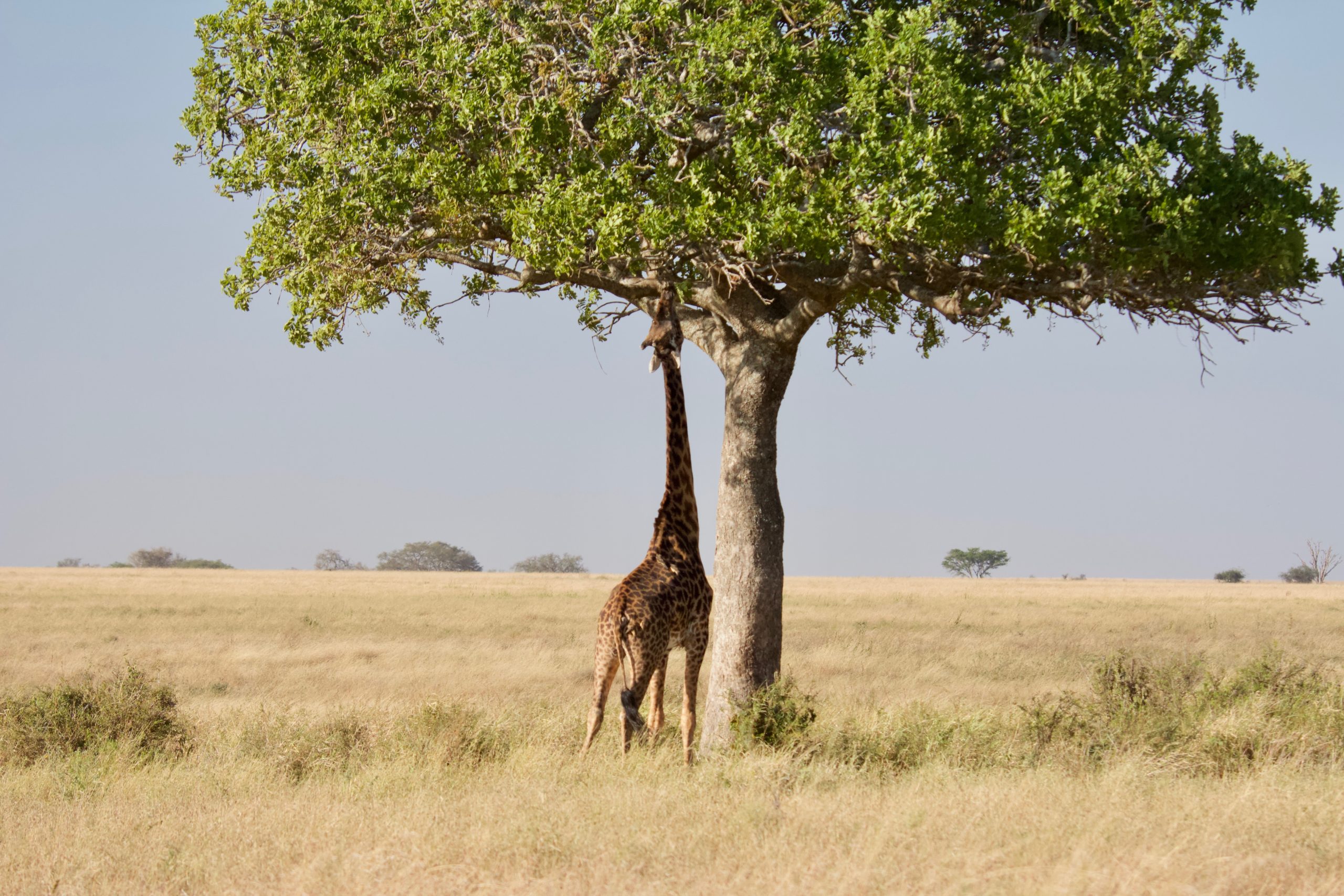
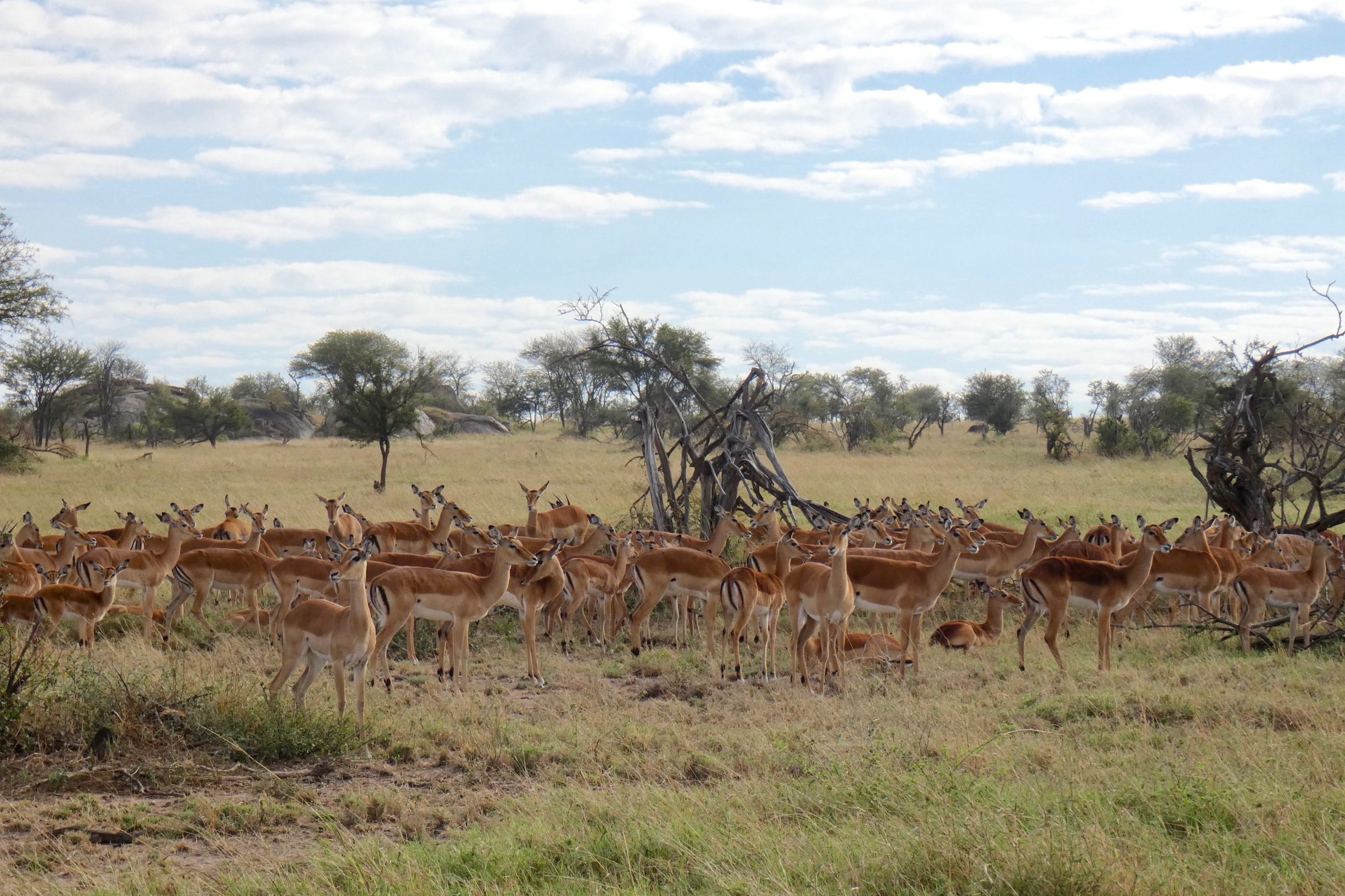
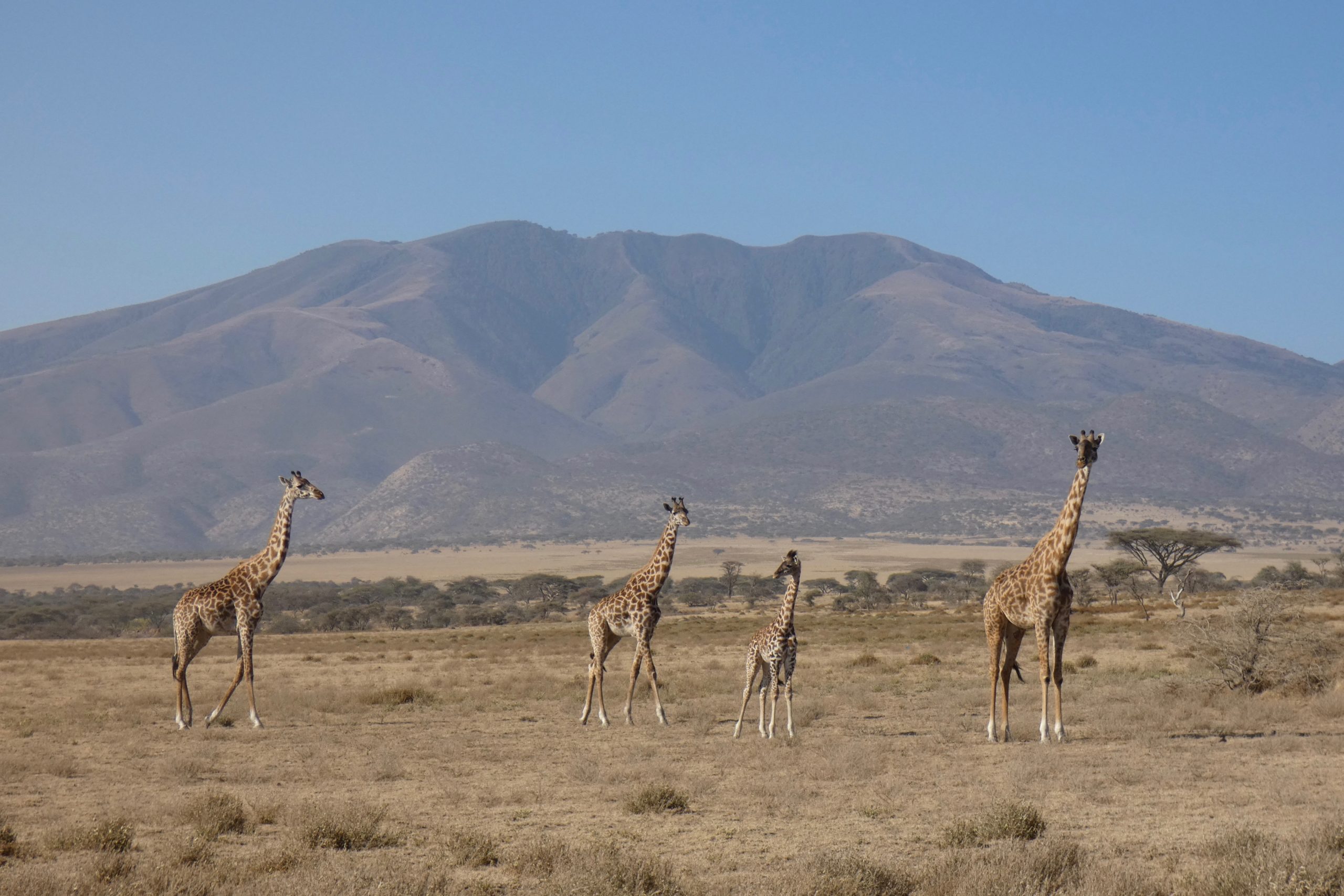
As we drove out, we passed a few giraffes and herds of Grant’s gazelles. As we neared the Mara region, we noticed an increasing number of wildebeest around us. They were literally scattered throughout the savannah as far as our eyes could see. Rather than head to our hotel, Gabriel headed straight for the Mara River, the river that separates Tanzania from Kenya, where the crossings typically occur.
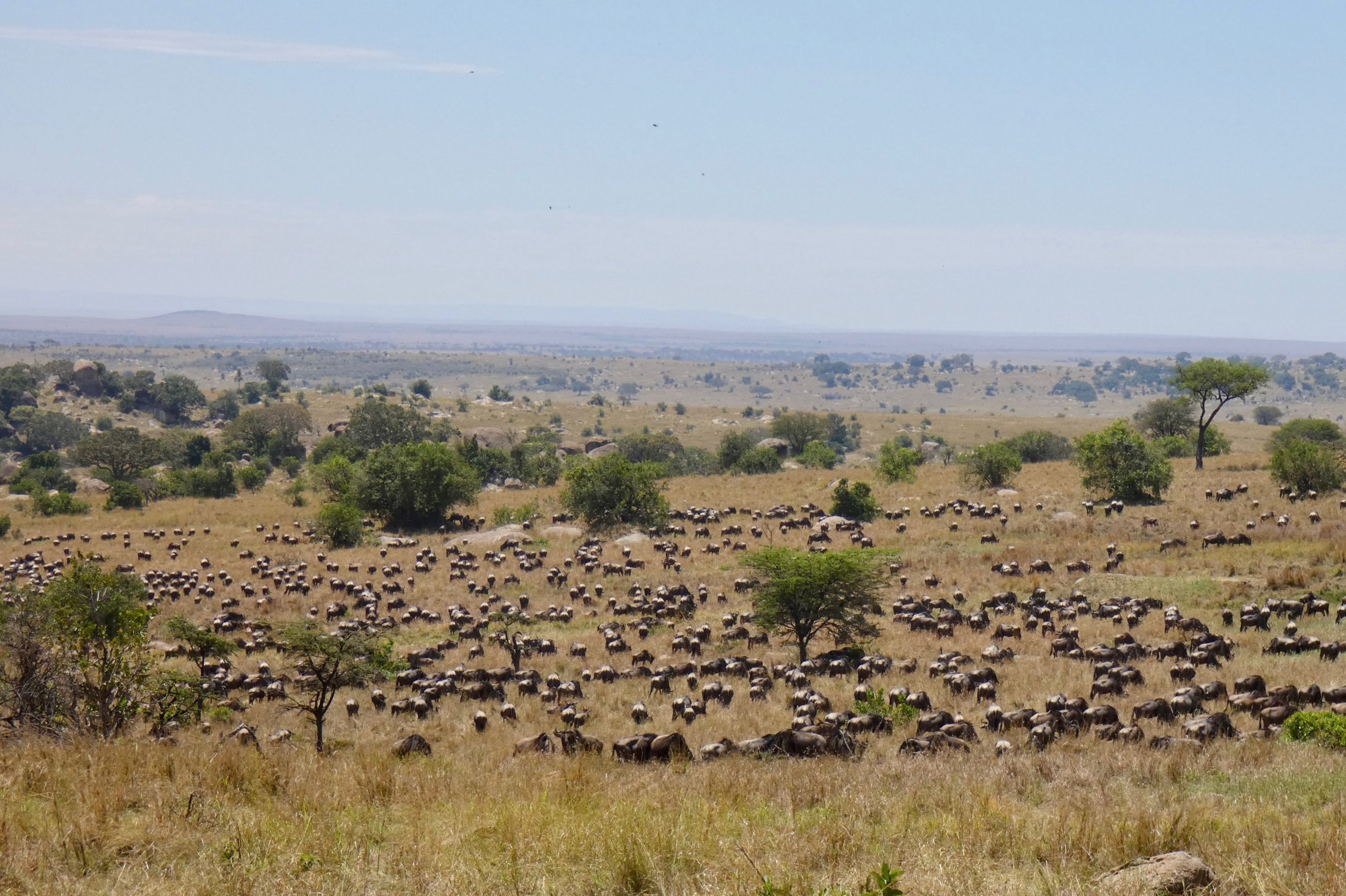
When we got to the river, a few vehicles were also close by, just waiting and watching – eyes glued on the opposite Kenyan side of the riverbank.
There were a couple of herds of wildebeest at the water’s edge, but they weren’t moving. All the guides knew to stay well out of sight to minimize any distraction that may deter them from crossing. Once one wildebeest leads the way, inevitably, the rest would follow.
At times, it almost felt like the wildebeest were toying with us; we’d see a single wildebeest head towards the water, leading a few others with it, but then it would change its mind and turn around, and the excitement would die with it. And that’s the unpredictability of it.
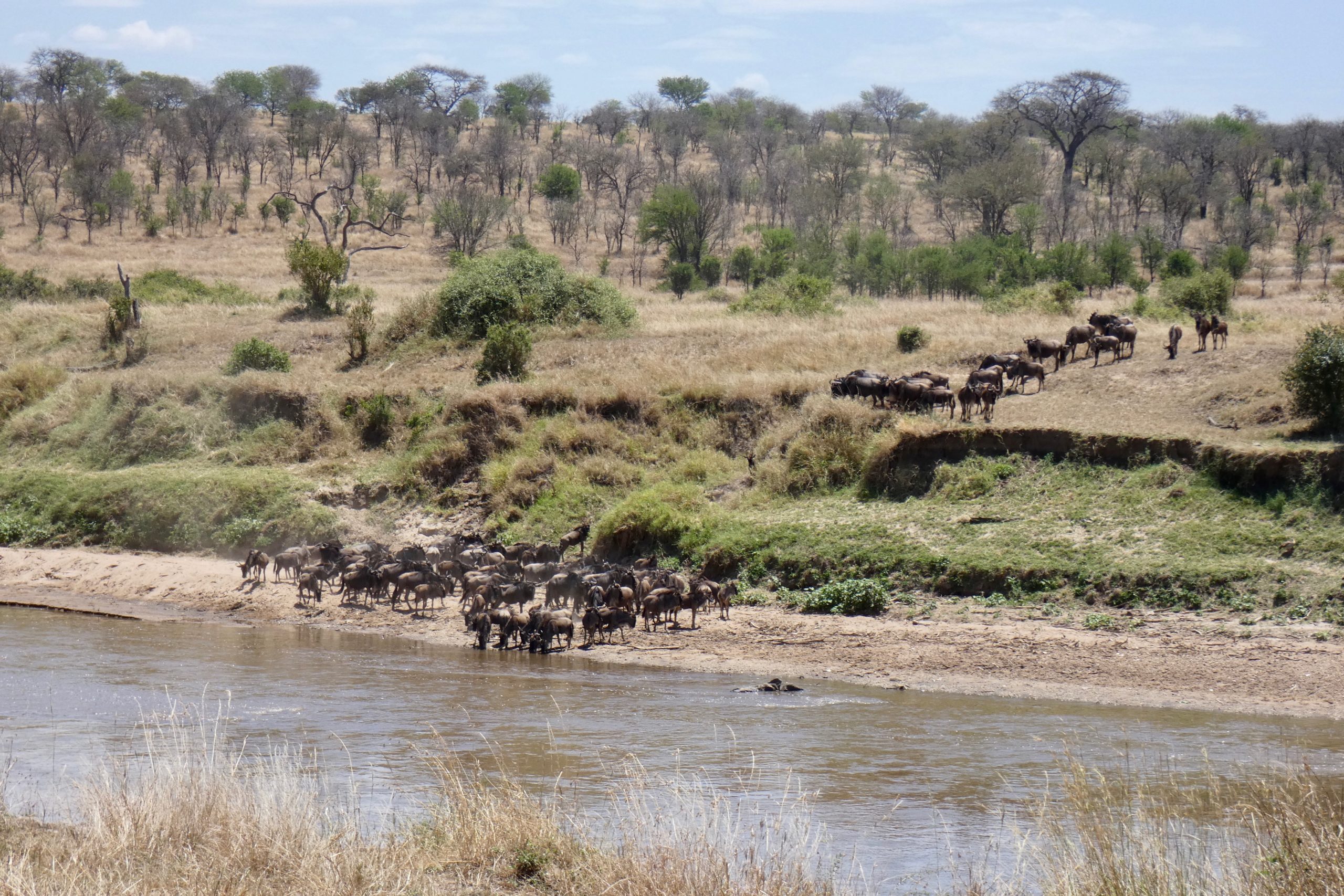
Patience is definitely the name of the game here. Some vehicles spent hours at the bank waiting for that moment, only for it not to happen. Even during the prime season for river crossings, there can be days between crossings. We encountered some frustrated guests during our trip, but that’s the gamble you take I guess.
We were very fortunate though as within the first hour of arriving, we caught not only one, but two massive crossings.
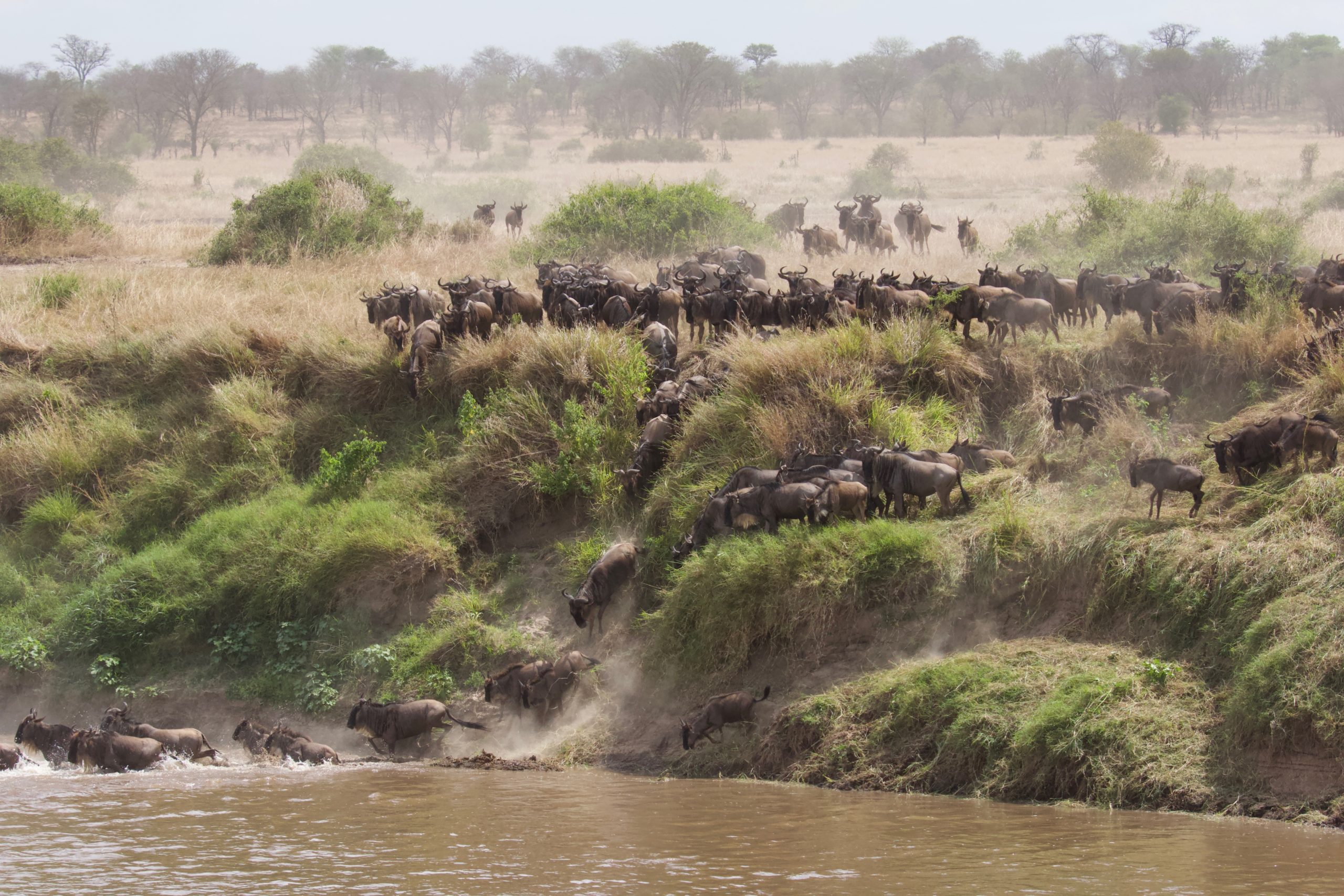
No words can describe the sense of exhilaration that comes upon you as you go from hopeful anticipation to the satisfaction of seeing the the first wildebeest take the plunge, followed by first a few, and then the rest of the herd behind it.
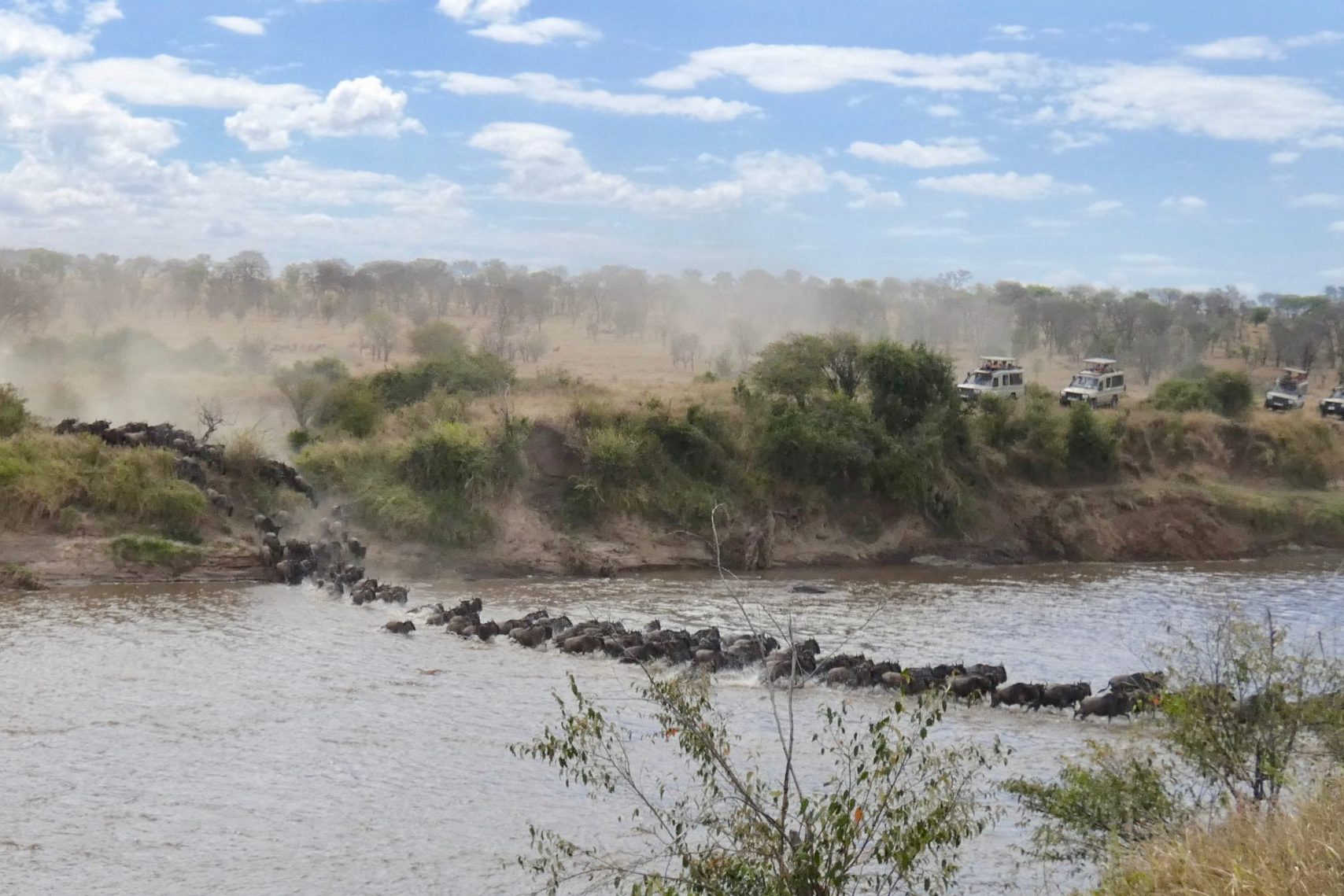
As soon as the herd followed, Gabriel told us to ‘hold on’ as he gunned it to the edge of the bank, as other vehicles also came darting from every direction in a race to the riverbank.
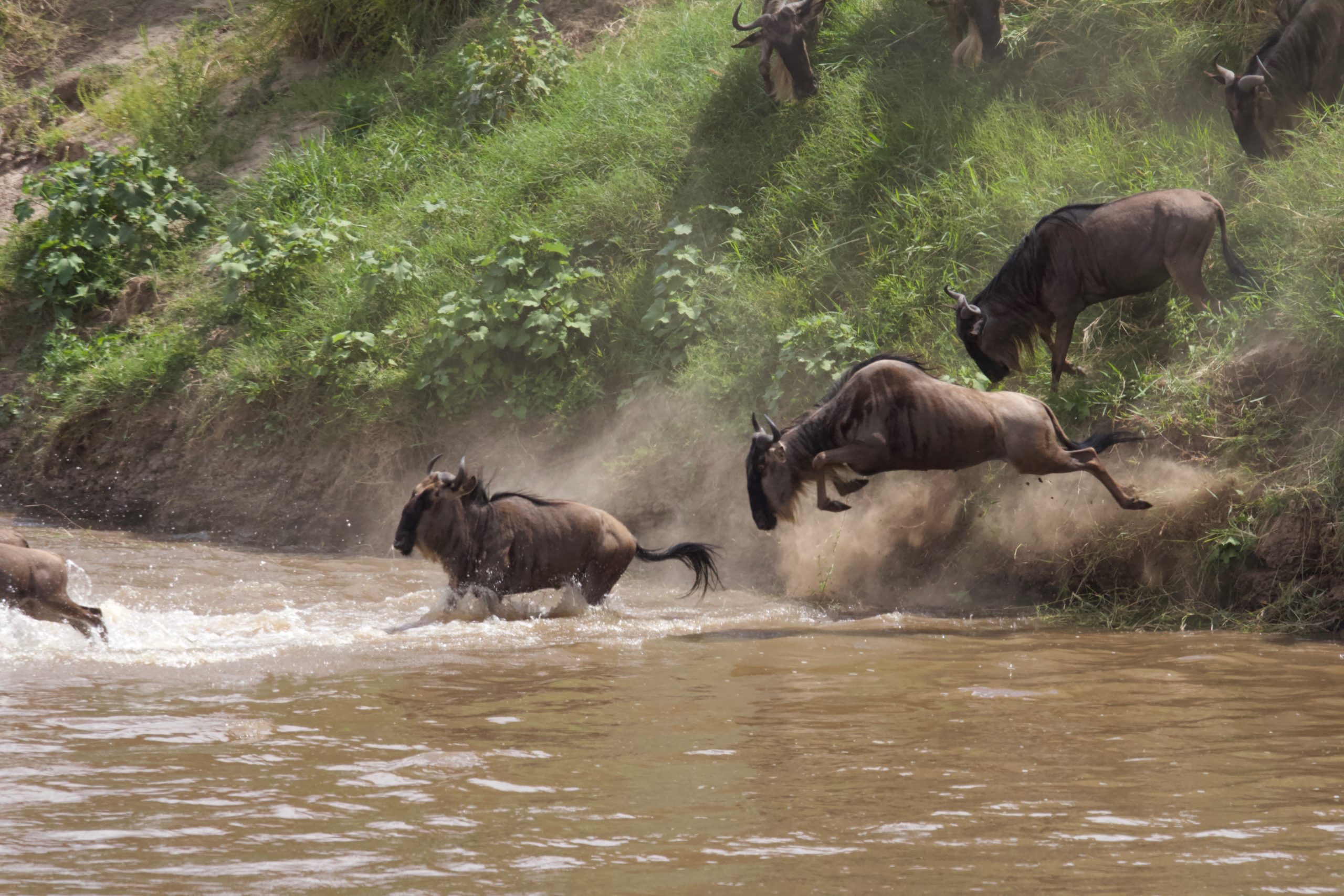
As the crossing ensued, it actually began moving closer to us, so close that wildebeest were at one point trekking up the bank right up to our vehicle. It was funny watching them. Once the first few wildebeest encountered our vehicle, they stopped in their tracks, not knowing where to go and holding up the rest of the herd.
They eventually figured it out and moved around our vehicle to reach the grasslands behind us. You would think it wouldn’t take long for a herd to cross the river, but it took over fifteen minutes! The wildebeest just kept coming from the Kenyan side from all directions, funnelling at the crossing point.
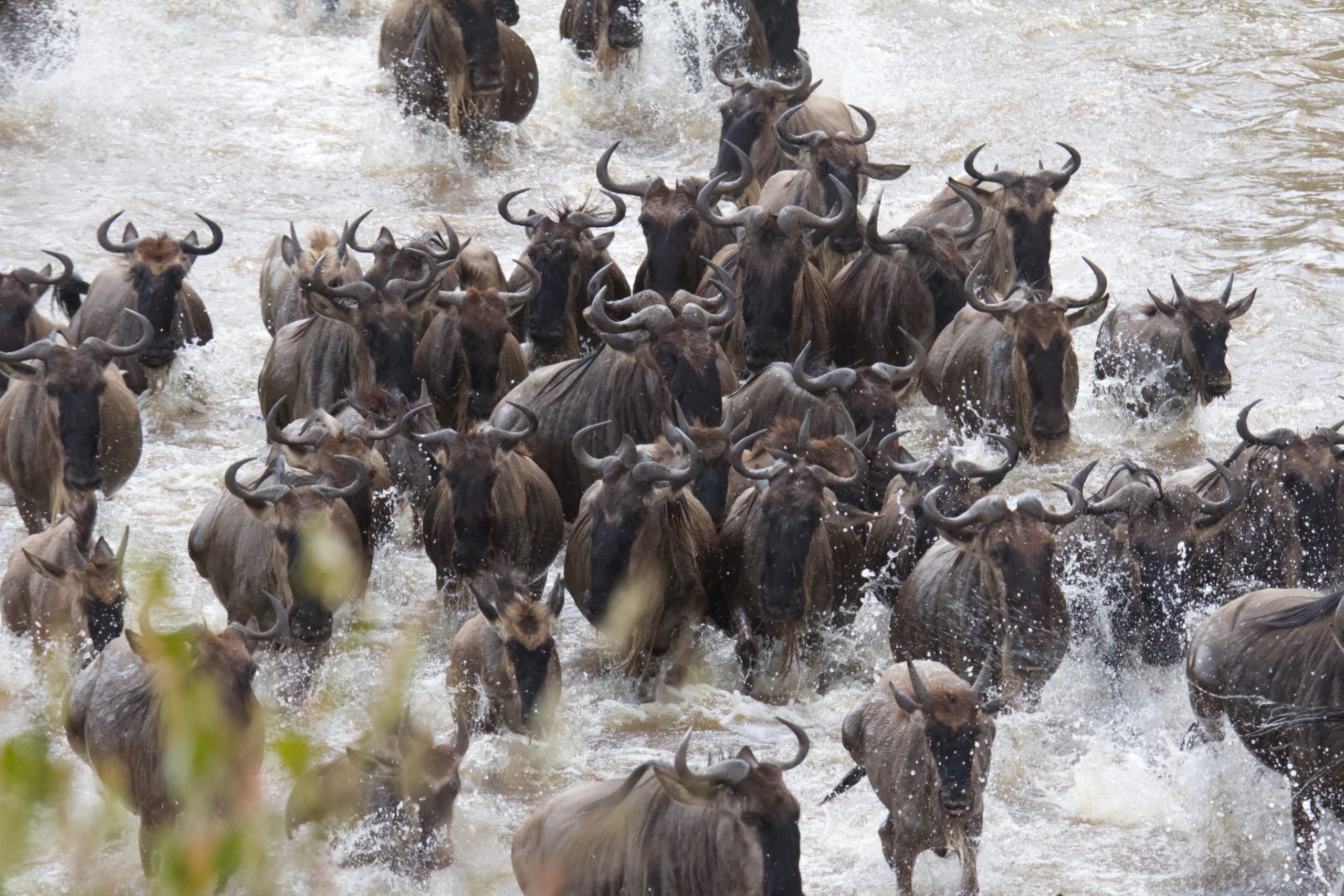
Once the wildebeest cross, they don’t necessarily stay on the Tanzanian side either. They may cross back and forth for several weeks before gradually continuing the migration into the southern Serengeti. Hence, you will also see many safari vehicles on the Kenyan side of the river, catching the wildebeest crossing back.
As if that weren’t enough excitement for the day, we also spotted a pair of mating lions on the way back to camp, that were at one point, no more than a few feet from us. We left just as the lioness began showing interest in a herd of wildebeest nearby. Unfortunately, the park was closing for the night, so we had to make it back to camp for curfew.
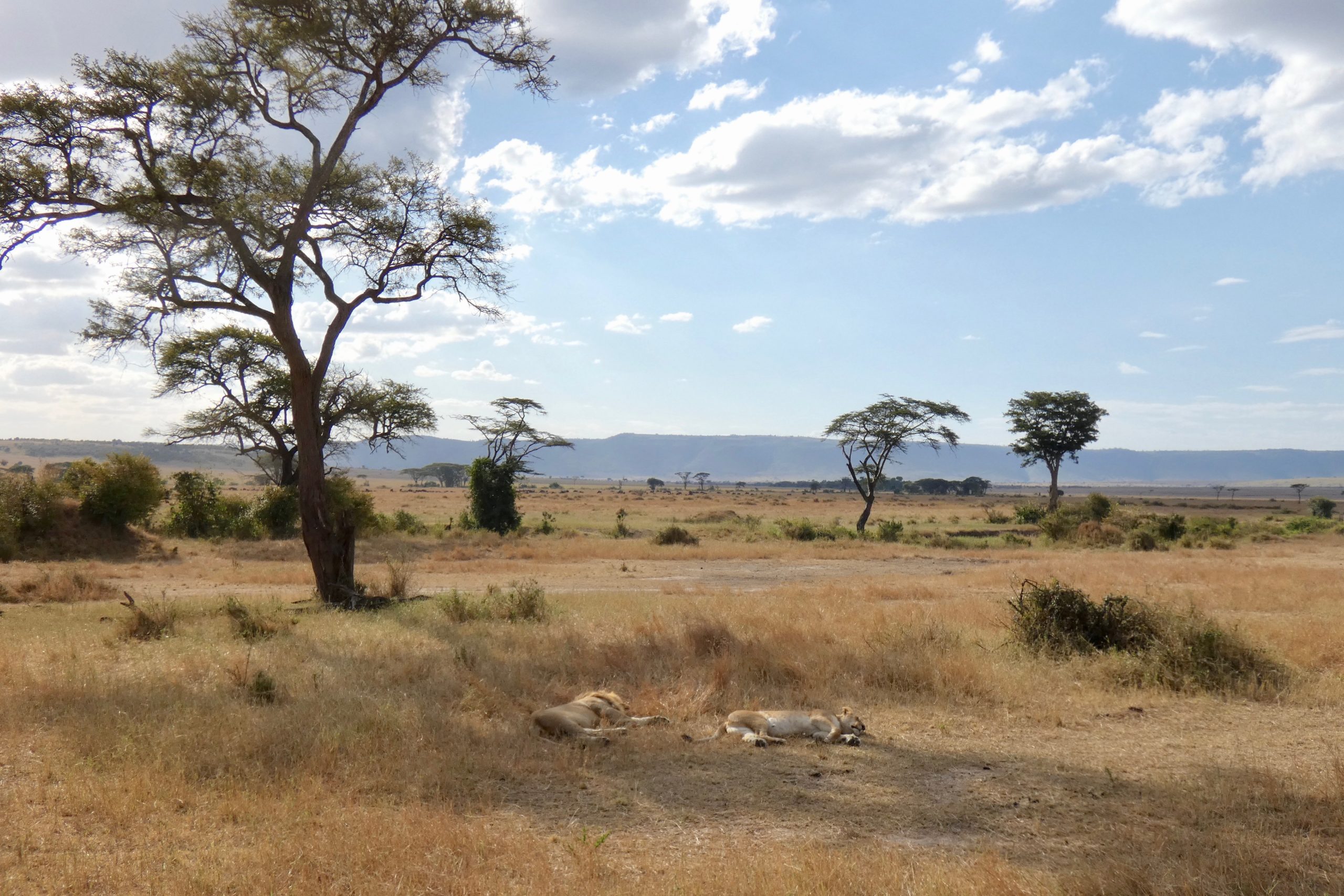
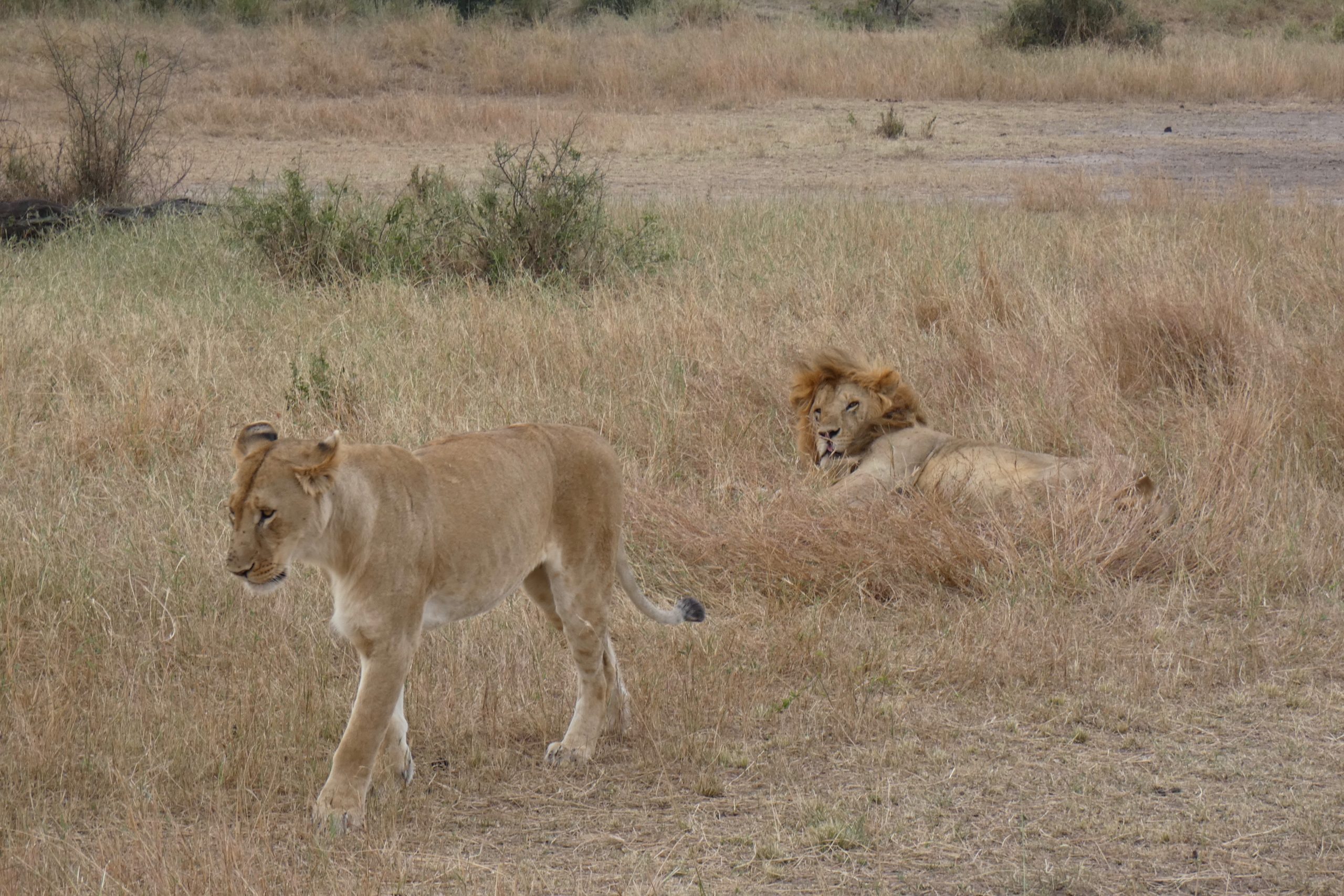
We stayed at Sayari Camp, which was more luxury glamping than camping. The advantage of this camp was its proximity to the crossings.
The tents were permanent structures elevated a couple of feet above ground, with a shower, running water and working toilet. Dining happens in a bigger tent complex, where guests can lounge and mingle with other guests.
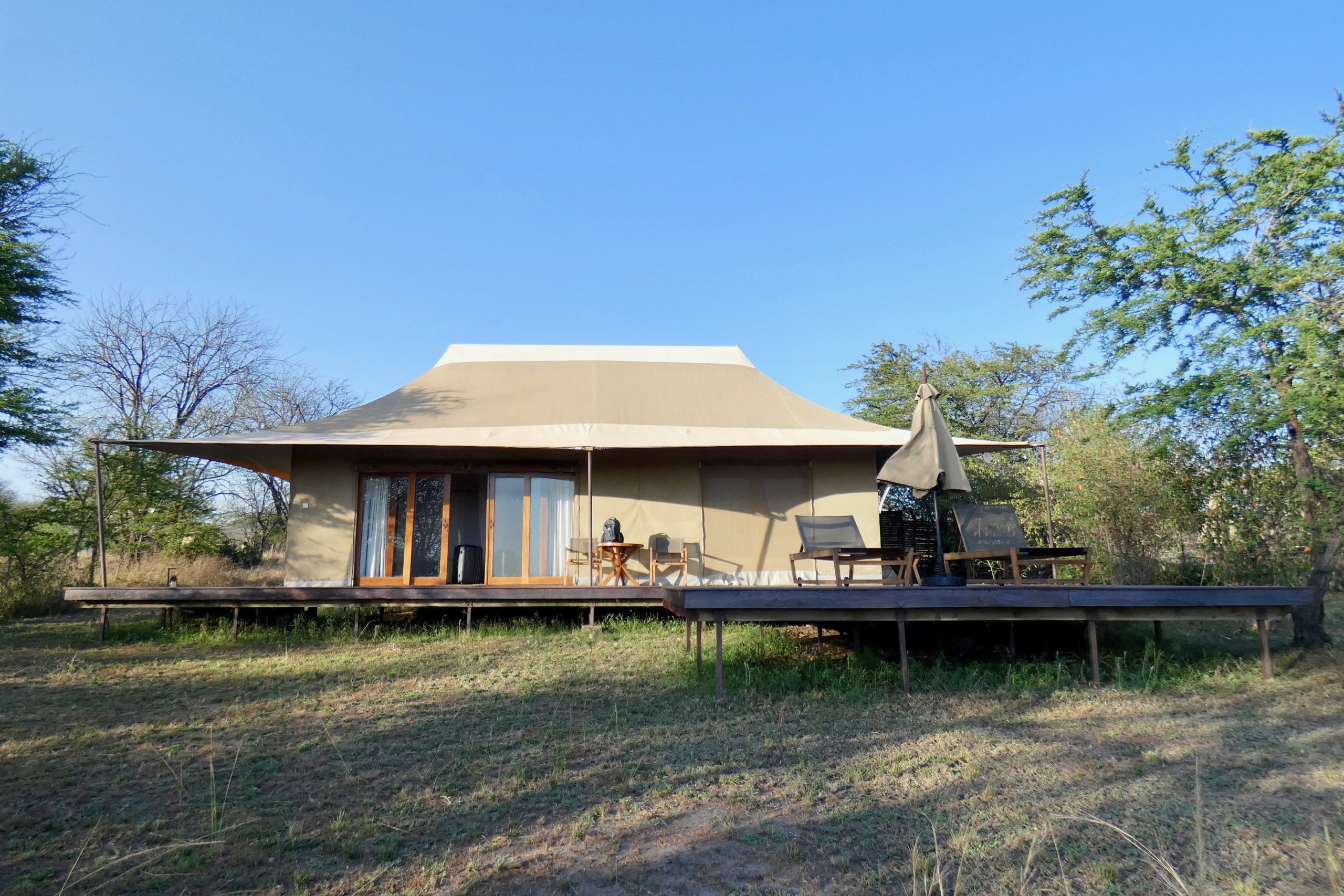
After dinner, we retired for the night to the grunting sounds of wildebeest passing by our tent… and to another unfamiliar yelping sound further in the distance, which we found out the next morning was that of a lion. Hence, you are advised not to leave your tent at night.
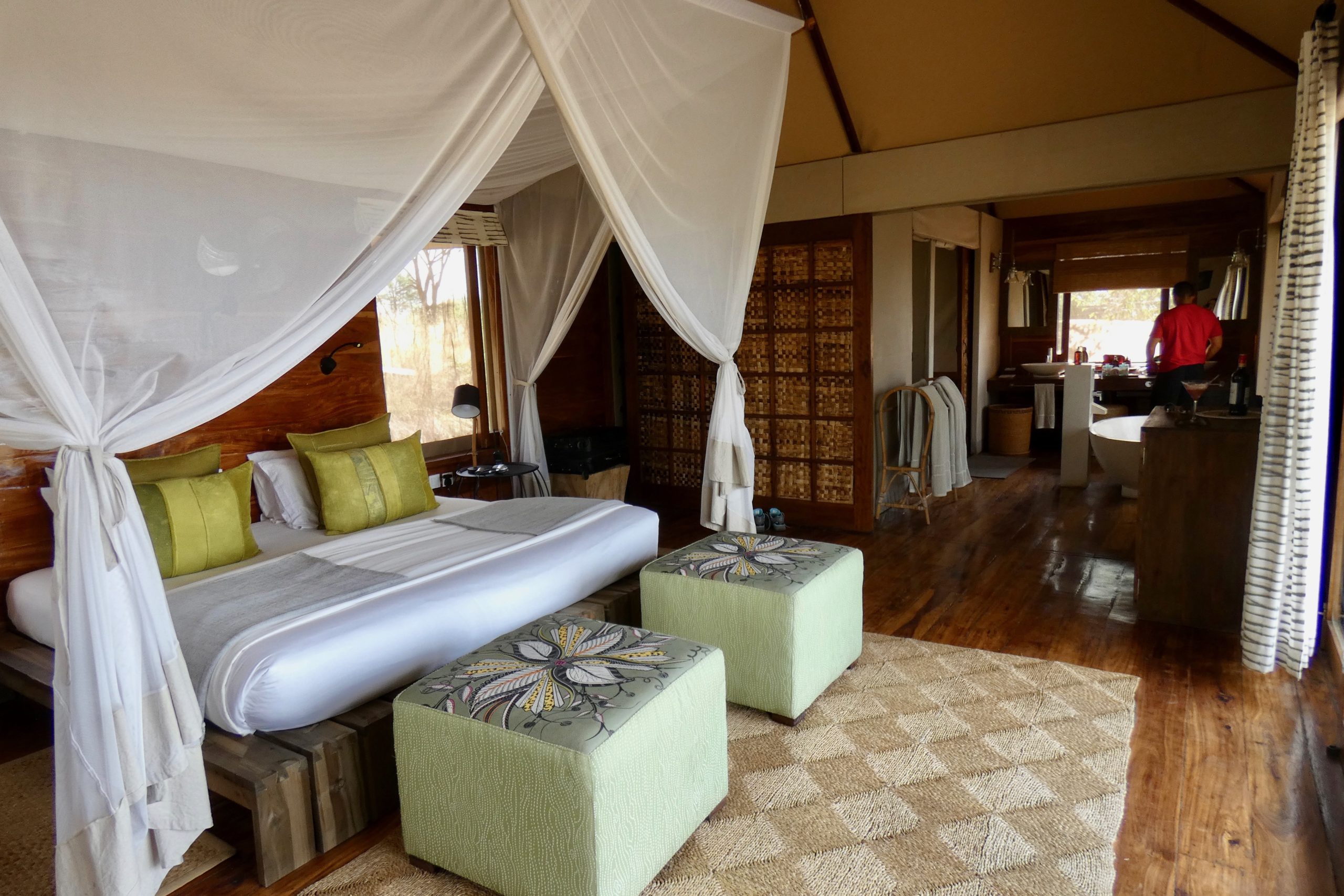
The next morning, we woke up bright and early for our hot air balloon ride. We debated whether this was worth the $500 per person price tag, but in the end, we went for it.
We were driven 30 minutes to the launch site right before daybreak. We got into the balloons and were in the air just in time to catch the beautiful sun rise over the Serengeti. We glided along the Mara River and over the savannah as wildebeest ran beneath us.
It was an amazing sight and felt like a scene taken from the Lion King. After landing, there was a champagne breakfast before our guides arrived to pick us up.

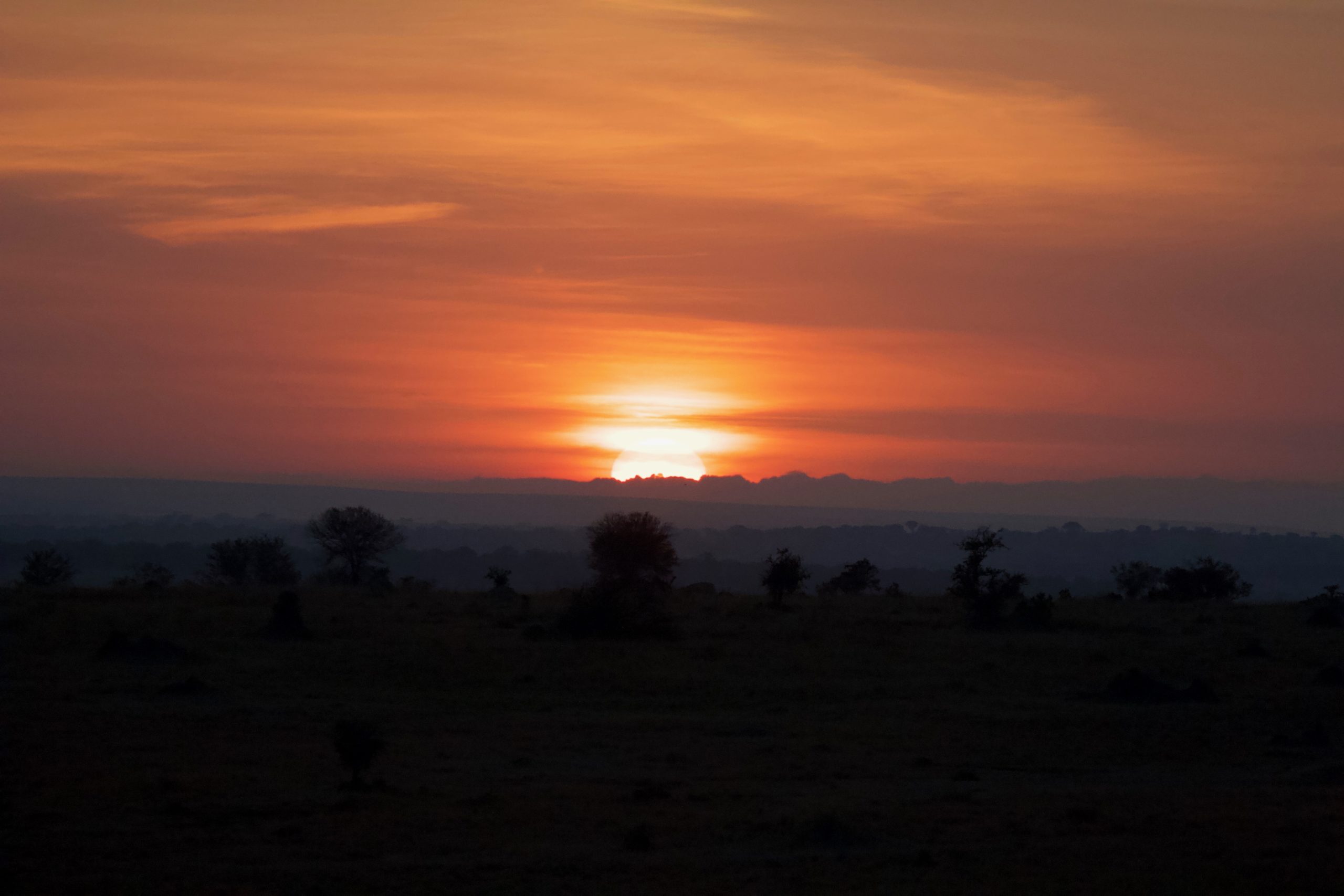
Today we were fortunate to catch yet another crossing. This time a couple of wildebeest didn’t quite make it. It’s like a stampede once the crossing gets under way, with wildebeest sometimes jumping on top of another, and sure enough, one wildebeest was left limping after crossing and couldn’t make it up the bank.
We also witnessed a crocodile take down a younger calf in the water. The Mara River is teeming with crocodiles, and where the river gets deeper, it makes for a more treacherous crossing. It was tragic, but in the savannah, it truly is survival of the fittest.
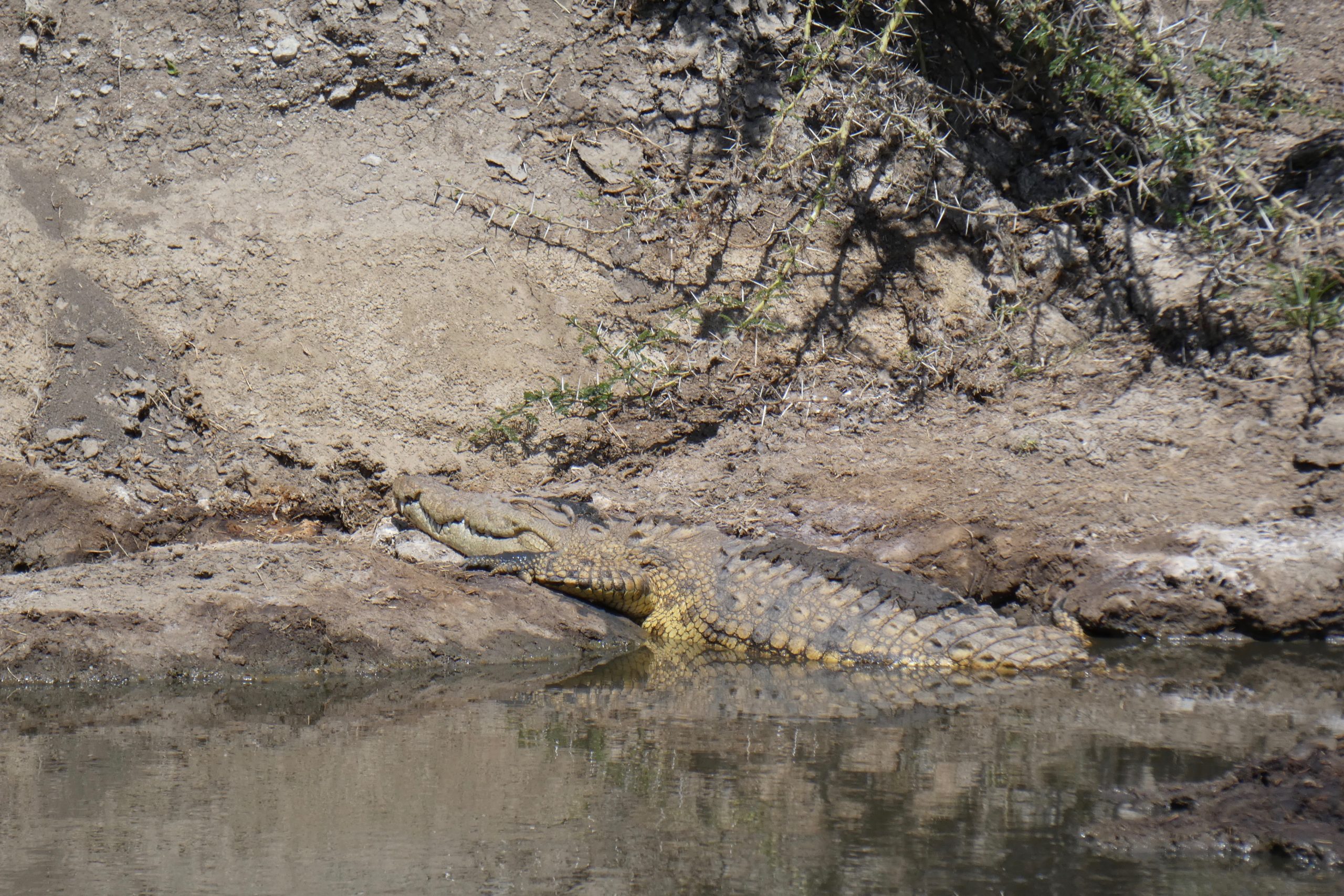
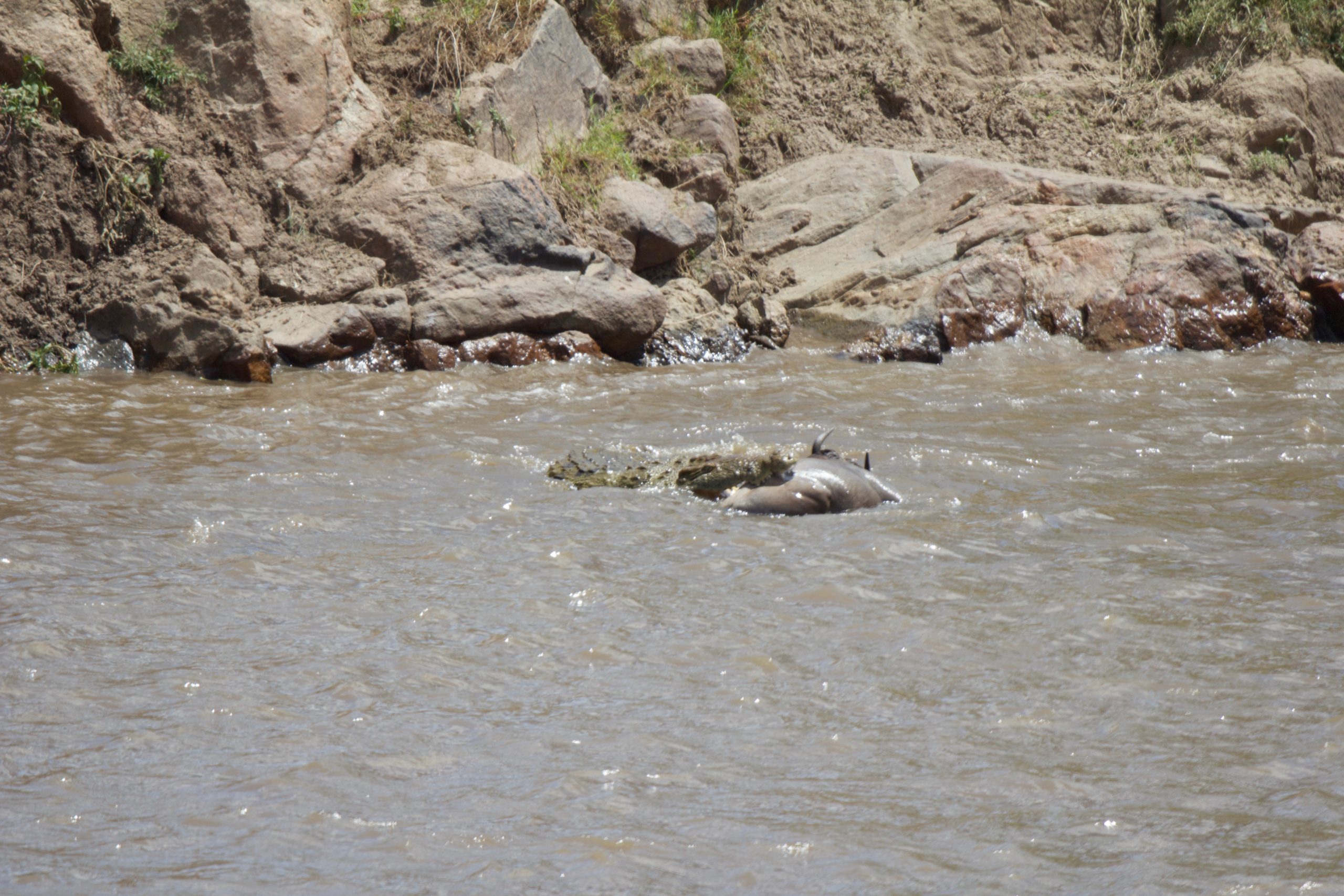
On our last morning, we woke up to wildebeest and zebra just grazing right outside our tent. It was once again a surreal moment. We sat on our deck just taking it all in before it was time to leave.
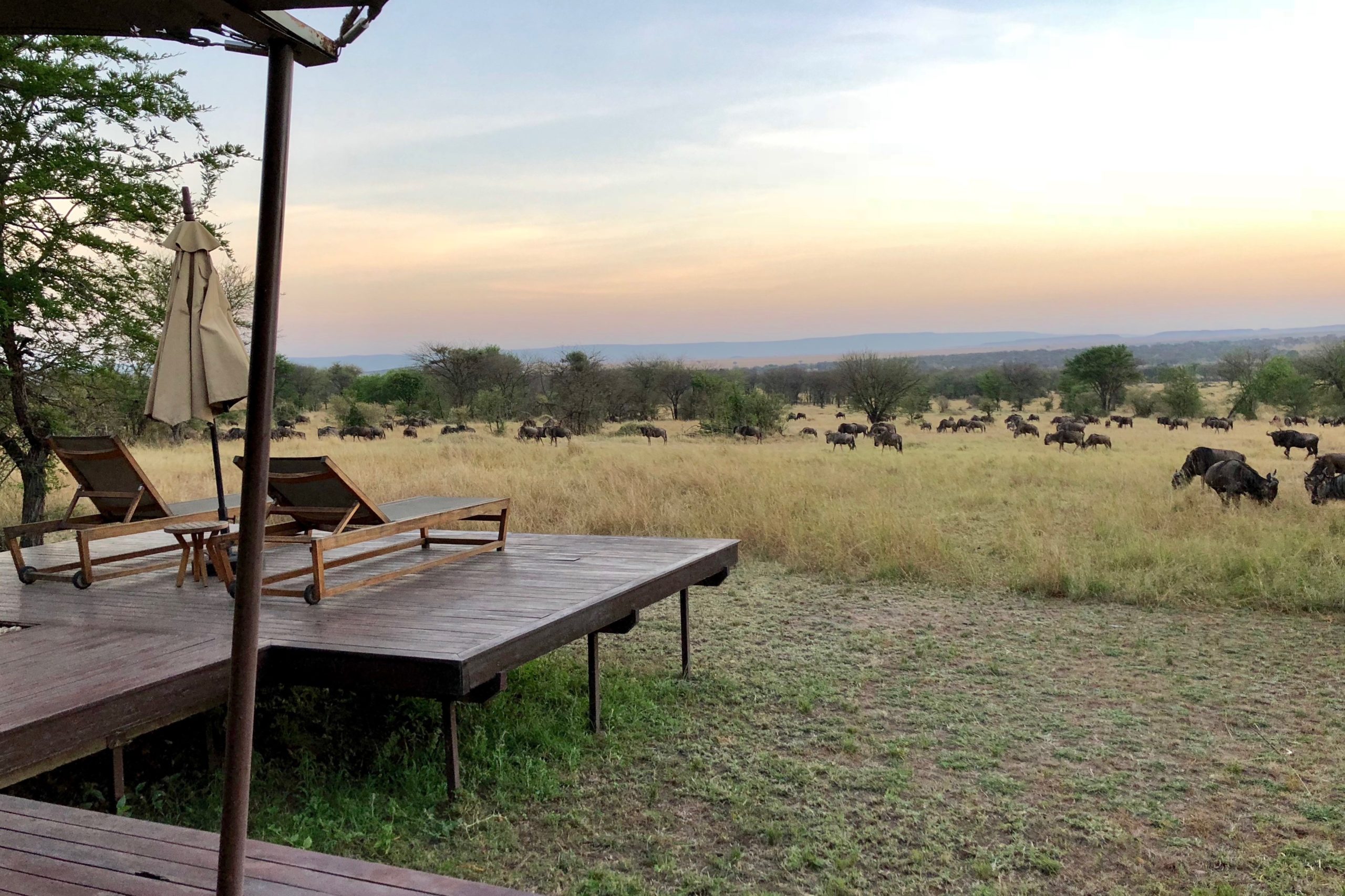
But there’s never a dull moment, as on the way to the airstrip, we saw the aftermath of a kill made the night prior, now surrounded by various birds of prey.
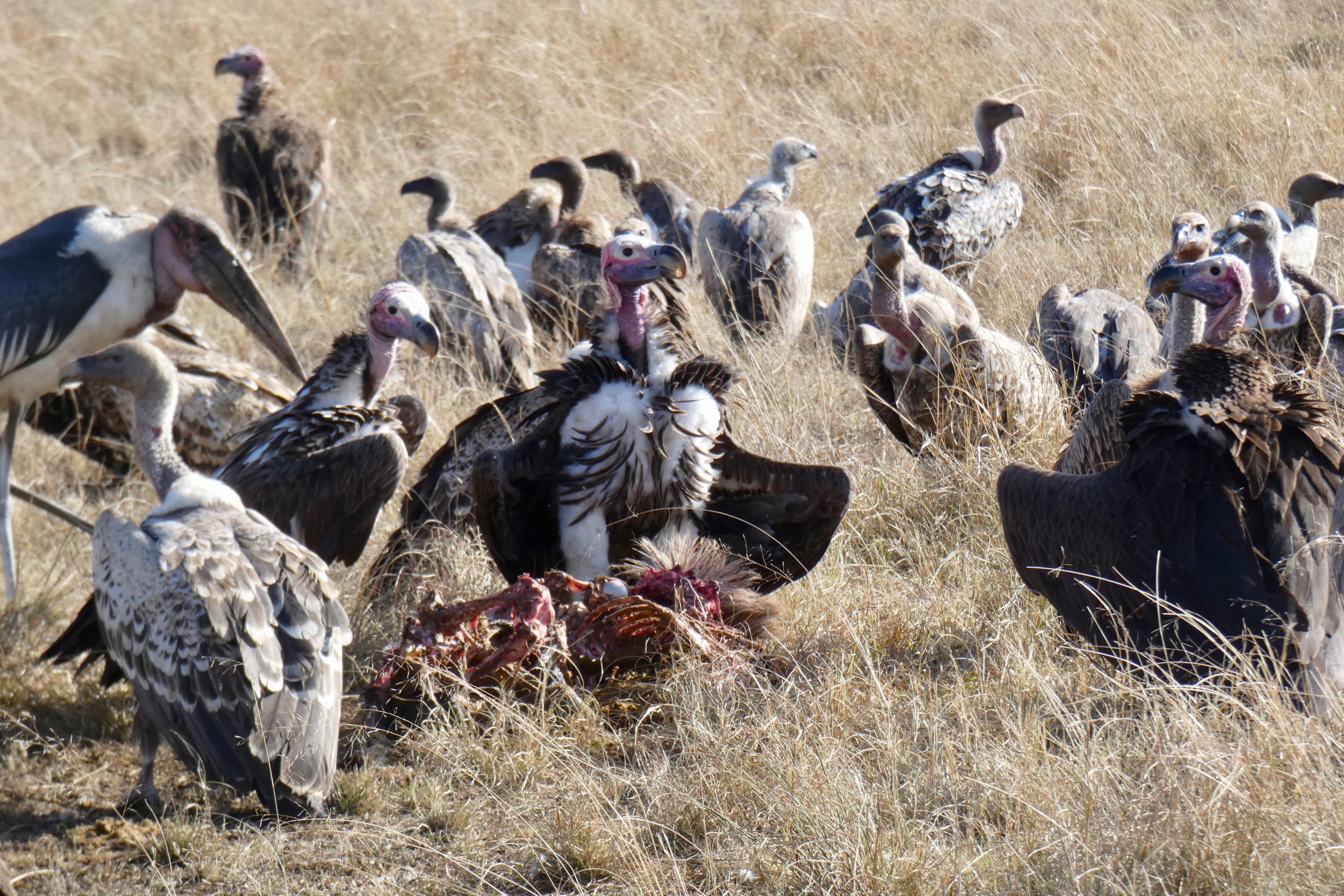
We gave our sincerest thanks to Gabriel before hopping onto a small eight-passenger plane back to Kilimanjaro, to catch our international flight to Milan and Lake Como, our final destination.
Conclusion
No film or photo can capture everything we experienced in Tanzania. It is truly an amazing country. We were lucky enough to see the “big five” of African safaris – the lion, leopard, rhinoceros, elephant and Cape buffalo – in addition to catching the magnificent river crossings.
Although I’ve given you a recap of our experiences, everyone’s experiences will be different, and that’s the beauty of it. Nature is unpredictable so there’s always an element of surprise to be had. Even the time on the road is not wasted as there’s always something to see, whether it be wildlife or catching a glimpse of the local culture and way of life.
I will definitely be back again. There is still so much more to do and see, like visit Lake Manyara to see the tree-climbing lions, go hunting with the Hadzabe bushmen around Lake Eyasi or see the first human remains in Olduvai Gorge. Near Tanzania, there is also gorilla trekking in Rwanda or Uganda that can be taken as a side trip. Perhaps I may even gather enough courage to hike up Mt. Kilimanjaro.
However, the draw to go back is not just for these experiences, as amazing as they are. It is easy for these experiences to overshadow the bigger issues the country faces, like poverty, famine, drought, and lack of access to good health care, education and clean water. There is no shortage of opportunities to join the humanitarian efforts both in Tanzania and Kenya, and I would love to be part of one of these in the future and give something back to this beautiful country and its people.
Before I sign off on this post, I leave you with the lyrics of the Jambo Song, a greeting sung to us in Tanzania that will always remind us of the wonderful time we had there.
Jambo, Jambo Bwana, Habari gani, Mzuri sana.
Wageni, mwakaribishwa, Tanzania yetu, Hakuna Matata
Tanzania nchi nzuri, Hakuna Matata.
Nchi yenye amani, Hakuna Matata.
Watu wote, Hakuna Matata,
Wakaribishwa, Hakuna Matata.
Hakuna Matata, Hakuna Matata.
Hello, hello, how are you, very fine.
Guests, you’re welcome, in our Tanzania, it’s no problem.
Tanzania is a beautiful country, it’s no problem.
A wonderful country, it’s no problem.
A peaceful country, it’s no problem.
All are welcome, it’s no problem.















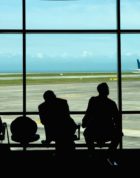



Good read but would have appreciated a breakdown of costs.
Your article bought me back to our safari in Tanzania in 1998. Also did a river safari. Nah!! Twelve days on safari is not too much. I encourage anybody who has bucket list trips to seriously consider taking them when it is safe.
Can you elaborate on the process of securing 12 nights of childcare?
We were very fortunate to have both sets of grandparents and a part-time nanny friend willing to help. Securing childcare is often the biggest challenge when booking trips without kids!
Good stuff Amy – though a rough budget/breakdown of costs would have been helpful!
What a wonderful journey, something straight out of National Geographic…. Make me want to book a trip just like that in the next few months. What an adventure! Great Post !!
Great read, Amy. Would love to see more of these posts in the future. Also, would love to see the Reader Success Stories series brought back too. Always fun to read about other trips that people have taken with their points!